Paul van Yperen's Blog, page 281
February 13, 2018
Catherine Zeta-Jones
Welsh actress Catherine Zeta-Jones (1969) was typecast as the token pretty girl in British films, and therefore relocated to Los Angeles. She established herself in Hollywood with sexy action roles in The Mask of Zorro (1998), Entrapment (1999) and the black comedy Intolerable Cruelty (2003).
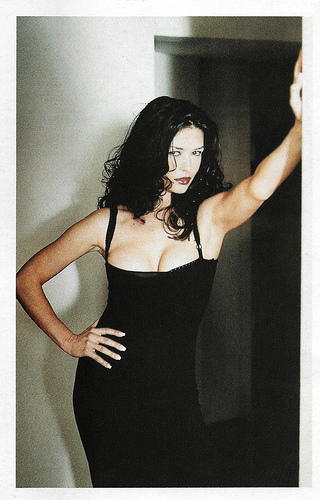
Belgian postcard by Pmagazine in the series 'De 50 mooiste vrouwen van de eeuw!' (the 50 most beautiful women of the century!), no. 3. Photo: Terry Doyle / Outline.
The Darling Buds of May
Catherine Zeta-Jones was born in Swansea in 1969. Her parents were David Jones, the owner of a candy factory, and his wife Patricia (née Fair), a seamstress. In the 1980s, her parents won £100.000 at the game of Bingo and moved to St. Andrews Drive in Mayals, uptown Swansea.
Because Zeta-Jones was a hyperactive child, her mother sent her to the Hazel Johnson School of Dance when she was four years old. Zeta-Jones participated in school stage shows from a young age and gained local media attention when her rendition of a Shirley Bassey song won a Junior Star Trail talent competition.
As a child, she played roles in the West End productions of the musicals Annie and Bugsy Malone. When she was 15, Zeta-Jones dropped out of school and decided to live in London to pursue a full-time acting career. She studied musical theatre at the Arts Educational Schools, London.
When she was 17 years old, she made her stage breakthrough with a leading role in a 1987 production of 42nd Street. Her next stage appearance was with the English National Opera at the London Coliseum in 1989 where she played Mae Jones in Kurt Weill's Street Scene.
Her screen debut came in the unsuccessful French-Italian film 1001 Nights (Philippe de Broca, 1990), as Sheherezade opposite Thierry Lhermitte . She had greater success as a regular in the British television series The Darling Buds of May (1991–1993).
Following a brief appearance as Beatriz Enríquez de Arana in the unsuccessful adventure film Christopher Columbus: The Discovery (John Glen, 1992), Zeta-Jones featured as a belly dancer in disguise in an episode of George Lucas' television series The Young Indiana Jones Chronicles (1992).
She next took on the part of an aspiring duchess in the farcical period drama Splitting Heirs (Robert Young, 1993), about two children (Eric Idle and Rick Moranis) who are separated at birth. She then starred as the pragmatic girlfriend of Sean Pertwee's character in the surf film Blue Juice (Carl Prechezer, 1995). Dismayed at being typecast as the token pretty girl in British films, Zeta-Jones relocated to Los Angeles.
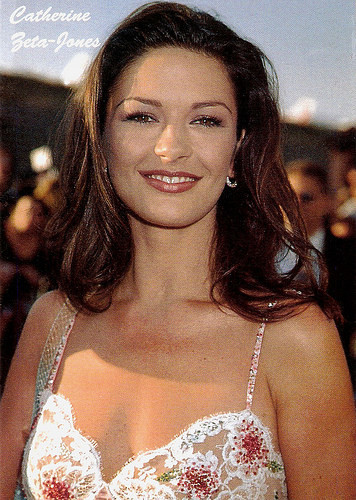
British postcard by Heroes Publishing Ltd., London, no. SPC 3491.
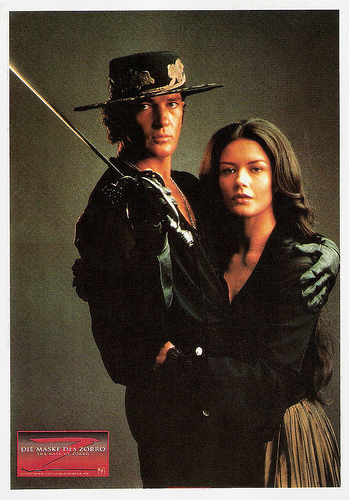
German postcard by Memory Cards, no. 495. Photo: publicity still for The Mask of Zorro (Martin Campbell, 1998), with Antonio Banderas .
The Mask of Zorro
Catherine Zeta-Jones initially established herself in Hollywood with roles that highlighted her sex appeal such as in the action film The Mask of Zorro (Martin Campbell, 1998) opposite Antonio Banderas , and the heist film Entrapment (Jon Amiel, 1999), in which she starred opposite Sean Connery as a seductive insurance agent on the lookout for an art thief.
Critics praised her portrayal of a vengeful pregnant woman in Traffic (Steven Soderbergh, 2000) and a murderous singer in the musical Chicago (Rob Marshall, 2002). For the first she was nominated for the Golden Globe Award for Best Supporting Actress. The latter won her Academy and BAFTA Awards for Best Supporting Actress, among other accolades.
In 2003, Zeta-Jones played alongside George Clooney in the Coen Brothers' black comedy Intolerable Cruelty. It was a commercial success.
She starred in high-profile films for much of the decade, including the heist film Ocean's Twelve (Steven Soderbergh, 2004), the comedy The Terminal (Steven Spielberg, 2004), and the romantic comedy No Reservations (Scott Hicks, 2007).
Parts in smaller-scale features were followed by a decrease in workload, during which she returned to stage and portrayed an ageing actress in A Little Night Music (2009), winning a Tony Award.
Zeta-Jones continued to work intermittently in the 2010s, starring in the psychological thriller Side Effects (Steven Soderbergh, 2013) and the action film Red 2 (Dean Parisot, 2013). Zeta-Jones is the recipient of several accolades, including an Academy Award, a British Academy Film Award and a Tony Award, and in 2010 she was appointed Commander of the Order of the British Empire (CBE) for her film and humanitarian endeavours. She supports various charities and causes, and is a prominent celebrity endorser of brands.
Her struggle with depression and bipolar II disorder has been well documented by the media. She was married to American actor Michael Douglas with whom she has two children.
Catherine Zeta-Jones was last seen in the cinemas with Toby Jones and Michael Gambon in the British comedy Dad's Army (Oliver Parker, 2016), based on the legendary TV series.
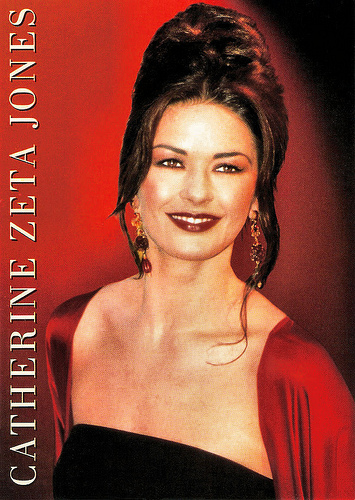
British postcard by Pyramid, Leicester, no. PC 2090, 1999.
Sources: Wikipedia and .

Belgian postcard by Pmagazine in the series 'De 50 mooiste vrouwen van de eeuw!' (the 50 most beautiful women of the century!), no. 3. Photo: Terry Doyle / Outline.
The Darling Buds of May
Catherine Zeta-Jones was born in Swansea in 1969. Her parents were David Jones, the owner of a candy factory, and his wife Patricia (née Fair), a seamstress. In the 1980s, her parents won £100.000 at the game of Bingo and moved to St. Andrews Drive in Mayals, uptown Swansea.
Because Zeta-Jones was a hyperactive child, her mother sent her to the Hazel Johnson School of Dance when she was four years old. Zeta-Jones participated in school stage shows from a young age and gained local media attention when her rendition of a Shirley Bassey song won a Junior Star Trail talent competition.
As a child, she played roles in the West End productions of the musicals Annie and Bugsy Malone. When she was 15, Zeta-Jones dropped out of school and decided to live in London to pursue a full-time acting career. She studied musical theatre at the Arts Educational Schools, London.
When she was 17 years old, she made her stage breakthrough with a leading role in a 1987 production of 42nd Street. Her next stage appearance was with the English National Opera at the London Coliseum in 1989 where she played Mae Jones in Kurt Weill's Street Scene.
Her screen debut came in the unsuccessful French-Italian film 1001 Nights (Philippe de Broca, 1990), as Sheherezade opposite Thierry Lhermitte . She had greater success as a regular in the British television series The Darling Buds of May (1991–1993).
Following a brief appearance as Beatriz Enríquez de Arana in the unsuccessful adventure film Christopher Columbus: The Discovery (John Glen, 1992), Zeta-Jones featured as a belly dancer in disguise in an episode of George Lucas' television series The Young Indiana Jones Chronicles (1992).
She next took on the part of an aspiring duchess in the farcical period drama Splitting Heirs (Robert Young, 1993), about two children (Eric Idle and Rick Moranis) who are separated at birth. She then starred as the pragmatic girlfriend of Sean Pertwee's character in the surf film Blue Juice (Carl Prechezer, 1995). Dismayed at being typecast as the token pretty girl in British films, Zeta-Jones relocated to Los Angeles.

British postcard by Heroes Publishing Ltd., London, no. SPC 3491.

German postcard by Memory Cards, no. 495. Photo: publicity still for The Mask of Zorro (Martin Campbell, 1998), with Antonio Banderas .
The Mask of Zorro
Catherine Zeta-Jones initially established herself in Hollywood with roles that highlighted her sex appeal such as in the action film The Mask of Zorro (Martin Campbell, 1998) opposite Antonio Banderas , and the heist film Entrapment (Jon Amiel, 1999), in which she starred opposite Sean Connery as a seductive insurance agent on the lookout for an art thief.
Critics praised her portrayal of a vengeful pregnant woman in Traffic (Steven Soderbergh, 2000) and a murderous singer in the musical Chicago (Rob Marshall, 2002). For the first she was nominated for the Golden Globe Award for Best Supporting Actress. The latter won her Academy and BAFTA Awards for Best Supporting Actress, among other accolades.
In 2003, Zeta-Jones played alongside George Clooney in the Coen Brothers' black comedy Intolerable Cruelty. It was a commercial success.
She starred in high-profile films for much of the decade, including the heist film Ocean's Twelve (Steven Soderbergh, 2004), the comedy The Terminal (Steven Spielberg, 2004), and the romantic comedy No Reservations (Scott Hicks, 2007).
Parts in smaller-scale features were followed by a decrease in workload, during which she returned to stage and portrayed an ageing actress in A Little Night Music (2009), winning a Tony Award.
Zeta-Jones continued to work intermittently in the 2010s, starring in the psychological thriller Side Effects (Steven Soderbergh, 2013) and the action film Red 2 (Dean Parisot, 2013). Zeta-Jones is the recipient of several accolades, including an Academy Award, a British Academy Film Award and a Tony Award, and in 2010 she was appointed Commander of the Order of the British Empire (CBE) for her film and humanitarian endeavours. She supports various charities and causes, and is a prominent celebrity endorser of brands.
Her struggle with depression and bipolar II disorder has been well documented by the media. She was married to American actor Michael Douglas with whom she has two children.
Catherine Zeta-Jones was last seen in the cinemas with Toby Jones and Michael Gambon in the British comedy Dad's Army (Oliver Parker, 2016), based on the legendary TV series.

British postcard by Pyramid, Leicester, no. PC 2090, 1999.
Sources: Wikipedia and .
Published on February 13, 2018 22:00
February 12, 2018
Anders de Wahl
Swedish actor Anders de Wahl (1869-1956) appeared in about seven films between 1920 and 1946. On stage, he was prolific and popular performer, mainly at Vasateatern, the Swedish Theatre and Dramaten - the Royal Dramatic Theatre in Stockholm.
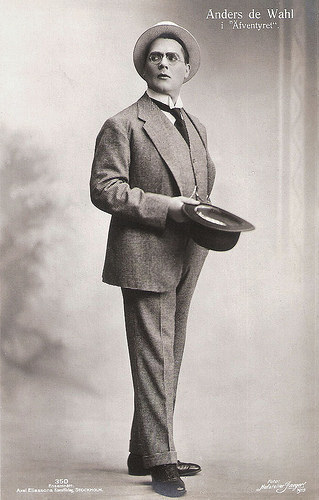
Swedish postcard by Axel Eliassons Konstförlag, Stockholm, no. 350. Photo: Hofatelier Jaeger, 1915. Publicity still for the play Afventyret by Valentin Le Barroyer, performed at the Dramaten theatre in Stockholm in 1915, under direction of Karl Hedberg.
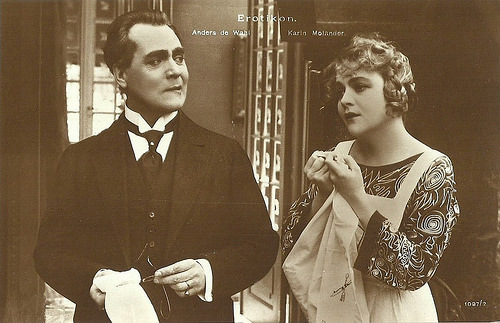
Swedish postcard by Nordisk Konst, Stockholm, no. 1097/2. Anders de Wahl and Karin Molander in Erotikon (Mauritz Stiller, 1920).
Dramaten
Anders de Wahl was born as Andreas de Wahl in 1869 in Stockholm, Sweden. He was the son of the music director Oscar de Wahl and the actress and operetta singer Anna de Wahl, born Lundström.
After employment at Wicanders cork factory offices, De Wahl was a student at Dramaten (the Royal Dramatic Theatre) from 1889 till 1891. There he debuted in 1890 as Nils in Mäster Olof (Master Olof) by August Strindberg.
From 1891 till 1892 he played for August Lindberg's theatre group and from 1892 till 1907 at the Albert Ranft Theatre Company. De Wahl wrote the play Too early, in which he played the role of Ville in 1892 which became one of his early successes.
From 1907 till 1919 he worked at Dramaten . In 1920-1922 he worked at the Svenska Teatern (Swedish Theatre) and again at Dramaten, from 1922 till 1951.
He often worked with the directors Olaf Molander and Alf Sjöberg. He also directed some plays himself. De Wahl also played in Copenhagen, Oslo and Helsinki, and conducted his own tours in the Swedish city centre. He also toured in the United States as a reader.
Martin Banham mentions in The Cambridge Guide to Theatre that De Wahl was popular until the late 1920s, when the more natural style of Lars Hanson replaced his romantic, exuberant style. De Wahl excelled as personality actor, often performing troubled souls as August Strindberg’s Erik XIV (1899) and his King Magnus (1901). Though he opposed modernism in theatre, he did perform in plays by Luigi Pirandello such as Six Characters in Search of an Author (1925), Henry IV (1926) and The Pleasure of Honesty (1930) and made the author thus popular in Sweden.
In 1930, he had an enormous success with the title role in Hjalmar Bergman's comedy Markurells from Wadköbing (1930). For posterity, Anders de Wahl will be inextricably linked with this role, in Sweden.
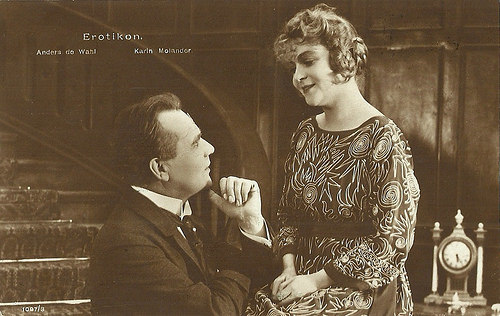
Swedish postcard by Nordisk Konst, Stockholm, no. 1097/3. Anders de Wahl and Karin Molander in Erotikon (Mauritz Stiller, 1920).
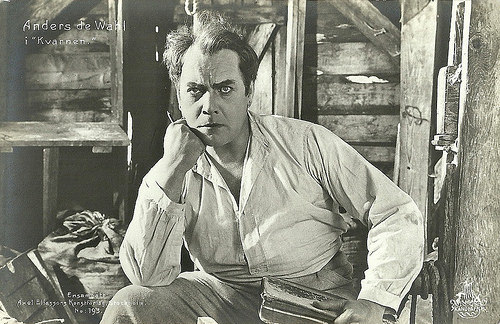
Swedish postcard by Axel Eliassons Konstförlag, Stockholm, no. 193. Photo: Skandia Film. Anders de Wahl in Kvarnen/The Windmill (John W. Brunius, 1921). The film was shot at the Skandia studio at Lidingö, with exteriors were shot at Sjöbo and Skåne by Hugo Edlund. The basis for the film was the novel Møllen (The Mill, 1896) by Karl Gjellerup. During filming in Sjöbo a real old mill burned down right in face of the camera. The Swedish Film Institute's film archive holds a restored print of the film.
Erotikon
In the cinema he became known when he starred in the silent, subversive tragi-comedy Erotikon (Mauritz Stiller, 1920). He played the entomology professor Leo Charpentier who is obsessed with the sexual life of bugs. In the meanwhile his easy-going wife ( Tora Teje ) is courted by two suitors. The film was based on a play by Hungarian writer Ferenc Herczeg and scripted by future film director Gustav Molander, Stiller and Arthur Nordén. Erotikon became a commercial success and was sold to 45 markets abroad.
In his second film Kvarnen/The Mill (John W. Brunius, 1921), De Wahl played a very different character as a miller who is lured and blinded by a seductive ‘tattare’ woman working at his farm.
De Wahl also appeared in the silent films Kalle Utter (Karin Swanström, 1925) and Flygande holländaren/Flying Dutchman (Karin Swanström, 1925), with German actor Werner Fuetterer .
His popularity diminished after the 1920s. After the introduction of the sound film, he played the lead in Vad veta väl männen/What do the men know? (Edvin Adolphson, 1933). It was the Swedish version of the German film Was wissen den Männer? (Gerhard Lamprecht, 1933).
Five years later he appeared in Med folket för fosterlandet (Sigurd Wallén, 1938) in which he was himself as the New Year's Reader of Lord Alfred Tennyson's poem New Year's Clock. De Wahl was famous in Sweden for calling in the New Year ("Ring klocka, ring..."/Ring Out, Wild Bells...) at Skansen in Stockholm for sixty years (1895-1955).
The grand old actor played his last stage role under the direction of Ingmar Bergman in Björn Erik Höijer's Light in the Shack.
Anders de Wahl died in Stockholm in 1956. He was 87. De Wahl was unmarried and is buried at Adolf Fredriks Cemetery in Stockholm.
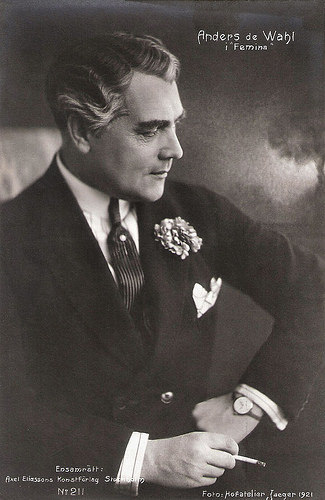
Swedish postcard by Axel Eliassons Konstförlag, Stockholm, no. 211. Photo: Hofatelier Jaeger, 1921. Publicity still for the play Femina.
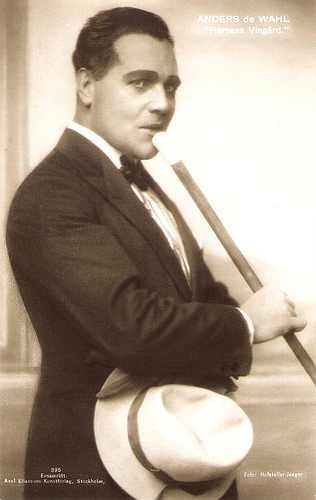
Swedish postcard by Axel Eliassons Konstförlag, Stockholm, no. 395. Photo: Hofatelier Jaeger. Publicity still for the play Herrans Vingard.
Sources: Martin Banham (Cambridge Guide to Theatre), Find A Grave, Wikipedia (Swedish, German and English) and .

Swedish postcard by Axel Eliassons Konstförlag, Stockholm, no. 350. Photo: Hofatelier Jaeger, 1915. Publicity still for the play Afventyret by Valentin Le Barroyer, performed at the Dramaten theatre in Stockholm in 1915, under direction of Karl Hedberg.

Swedish postcard by Nordisk Konst, Stockholm, no. 1097/2. Anders de Wahl and Karin Molander in Erotikon (Mauritz Stiller, 1920).
Dramaten
Anders de Wahl was born as Andreas de Wahl in 1869 in Stockholm, Sweden. He was the son of the music director Oscar de Wahl and the actress and operetta singer Anna de Wahl, born Lundström.
After employment at Wicanders cork factory offices, De Wahl was a student at Dramaten (the Royal Dramatic Theatre) from 1889 till 1891. There he debuted in 1890 as Nils in Mäster Olof (Master Olof) by August Strindberg.
From 1891 till 1892 he played for August Lindberg's theatre group and from 1892 till 1907 at the Albert Ranft Theatre Company. De Wahl wrote the play Too early, in which he played the role of Ville in 1892 which became one of his early successes.
From 1907 till 1919 he worked at Dramaten . In 1920-1922 he worked at the Svenska Teatern (Swedish Theatre) and again at Dramaten, from 1922 till 1951.
He often worked with the directors Olaf Molander and Alf Sjöberg. He also directed some plays himself. De Wahl also played in Copenhagen, Oslo and Helsinki, and conducted his own tours in the Swedish city centre. He also toured in the United States as a reader.
Martin Banham mentions in The Cambridge Guide to Theatre that De Wahl was popular until the late 1920s, when the more natural style of Lars Hanson replaced his romantic, exuberant style. De Wahl excelled as personality actor, often performing troubled souls as August Strindberg’s Erik XIV (1899) and his King Magnus (1901). Though he opposed modernism in theatre, he did perform in plays by Luigi Pirandello such as Six Characters in Search of an Author (1925), Henry IV (1926) and The Pleasure of Honesty (1930) and made the author thus popular in Sweden.
In 1930, he had an enormous success with the title role in Hjalmar Bergman's comedy Markurells from Wadköbing (1930). For posterity, Anders de Wahl will be inextricably linked with this role, in Sweden.

Swedish postcard by Nordisk Konst, Stockholm, no. 1097/3. Anders de Wahl and Karin Molander in Erotikon (Mauritz Stiller, 1920).

Swedish postcard by Axel Eliassons Konstförlag, Stockholm, no. 193. Photo: Skandia Film. Anders de Wahl in Kvarnen/The Windmill (John W. Brunius, 1921). The film was shot at the Skandia studio at Lidingö, with exteriors were shot at Sjöbo and Skåne by Hugo Edlund. The basis for the film was the novel Møllen (The Mill, 1896) by Karl Gjellerup. During filming in Sjöbo a real old mill burned down right in face of the camera. The Swedish Film Institute's film archive holds a restored print of the film.
Erotikon
In the cinema he became known when he starred in the silent, subversive tragi-comedy Erotikon (Mauritz Stiller, 1920). He played the entomology professor Leo Charpentier who is obsessed with the sexual life of bugs. In the meanwhile his easy-going wife ( Tora Teje ) is courted by two suitors. The film was based on a play by Hungarian writer Ferenc Herczeg and scripted by future film director Gustav Molander, Stiller and Arthur Nordén. Erotikon became a commercial success and was sold to 45 markets abroad.
In his second film Kvarnen/The Mill (John W. Brunius, 1921), De Wahl played a very different character as a miller who is lured and blinded by a seductive ‘tattare’ woman working at his farm.
De Wahl also appeared in the silent films Kalle Utter (Karin Swanström, 1925) and Flygande holländaren/Flying Dutchman (Karin Swanström, 1925), with German actor Werner Fuetterer .
His popularity diminished after the 1920s. After the introduction of the sound film, he played the lead in Vad veta väl männen/What do the men know? (Edvin Adolphson, 1933). It was the Swedish version of the German film Was wissen den Männer? (Gerhard Lamprecht, 1933).
Five years later he appeared in Med folket för fosterlandet (Sigurd Wallén, 1938) in which he was himself as the New Year's Reader of Lord Alfred Tennyson's poem New Year's Clock. De Wahl was famous in Sweden for calling in the New Year ("Ring klocka, ring..."/Ring Out, Wild Bells...) at Skansen in Stockholm for sixty years (1895-1955).
The grand old actor played his last stage role under the direction of Ingmar Bergman in Björn Erik Höijer's Light in the Shack.
Anders de Wahl died in Stockholm in 1956. He was 87. De Wahl was unmarried and is buried at Adolf Fredriks Cemetery in Stockholm.

Swedish postcard by Axel Eliassons Konstförlag, Stockholm, no. 211. Photo: Hofatelier Jaeger, 1921. Publicity still for the play Femina.

Swedish postcard by Axel Eliassons Konstförlag, Stockholm, no. 395. Photo: Hofatelier Jaeger. Publicity still for the play Herrans Vingard.
Sources: Martin Banham (Cambridge Guide to Theatre), Find A Grave, Wikipedia (Swedish, German and English) and .
Published on February 12, 2018 22:00
February 11, 2018
Cas Jansen
Dutch actor Cas Jansen (1977) became a teen idol with the popular Dutch soap Goede Tijden, Slechte Tijden/Good Times, Bad Times (1996-1999). Later he starred in several Dutch films, including the award-winning thriller Lek/Leak (2000).

Dutch postcard in the GTST-verzamelkaarten series by Grundy / Joop van den Ende Productions / RTL4 / Veronica De Holland Media Group / Entres / Photo Sportivo, no. 3. Photo: Govert de Roos. Publicity still for Goede Tijden Slechte Tijden/GTST (1996-1999) with Cas Jansen as Julian Verduyn.
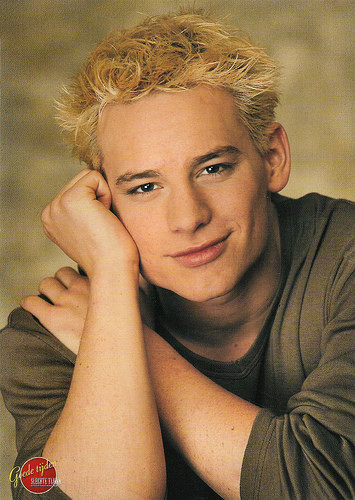
Dutch postcard in the GTST-verzamelkaarten series by Grundy / Joop van den Ende Productions / RTL4 / Veronica De Holland Media Group / Entres / Photo Sportivo, no. 18. Photo: Govert de Roos. Publicity still for Goede Tijden Slechte Tijden/GTST (1996-1999) with Cas Jansen as Julian Verduyn.
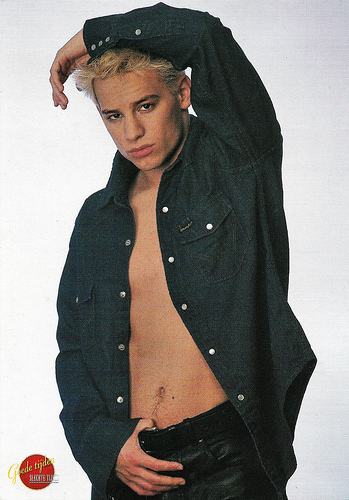
Dutch postcard in the GTST-verzamelkaarten series by Grundy / Joop van den Ende Productions / RTL4 / Veronica De Holland Media Group / Entres / Photo Sportivo, no. 19. Photo: Govert de Roos. Publicity still for Goede Tijden Slechte Tijden/GTST (1996-1999) with Cas Jansen as Julian Verduyn.
Lord of the Flies
Cas Jansen was born Casper Jansen in 1977 in Badhoevedorp, the Netherlands.
At the age of 11, Jansen played on stage at Jeugd Theater De Krakeling in Amsterdam in the play Strandrand, a Dutch translation of Lord of the Flies by William Golding. He also appeared on stage in Ubu Roi (1993) and King Lear (1995).
In addition, Jansen played in several television series, including Fort Alpha (1996-1997). He became very popular with his role as Julian Verduyn in the TV soap Goede Tijden, Slechte Tijden/Good Times, Bad Times (1996-1999).
Then he got a small part in the film Karakter/Character (Mike van Diem, 1997), starring Fedja van Huêt and Jan Decleir. This film won the Oscar for Best Foreign Film.
Jansen was featured in the television series All Stars (1999-2001) as pot-head Nemo. His final breakthrough was the leading role as police officer Eddy Dolstra in the thriller Lek/Leak (Jean van de Velde, 2000), which won several Golden Calf awards, including for Best Feature.
For two seasons, he performed the role of detective Chris Luifel in the second season of the television series Luifel and Luifel (2002-2003). In this crime series his character solved murder cases with his father (Guus Dam).
Jansen then performed in the films Volle Maan/Full Moon Party (Johan Nijenhuis, 2002), and De Dominee/The Preacher (Gerrard Verhage, 2004), based on the life of gangster Klaas Bruinsma who was played by Peter Paul Muller.
Jansen played another supporting part in the Dutch action comedy Vet hard/Too Fat Too Furious (Tim Oliehoek, 2005), starring Jack Wouterse. This is a remake of the Danish comedy Gamle mænd i nye biler/Old Men in New Cars (Lasse Spang Olsen, 2002) and received a Golden Film for 100,000 visitors.
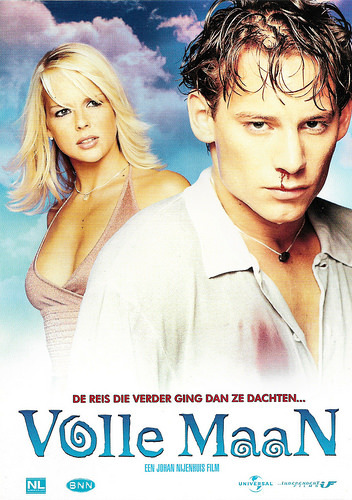
Dutch postcard by Boomerang, Amsterdam. Photo: Ray Christian / De Krom Studio. Artwork: Michiel van Randeraat/ Locust Enterainment. Promotion card for Volle Maan/Full Moon Party (Johan Nijenhuis, 2002) with Chantal Janzen.
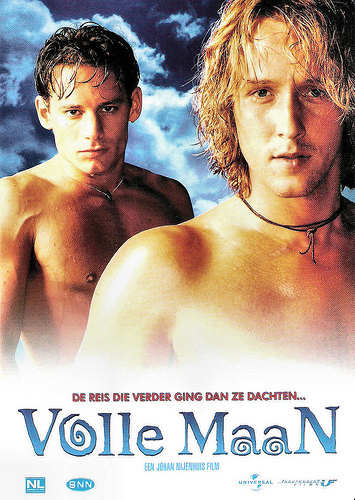
Dutch postcard by Boomerang, Amsterdam. Photo: Ray Christian / De Krom Studio. Artwork: Michiel van Randeraat/ Locust Enterainment. Promotion card for Volle Maan/Full Moon Party (Johan Nijenhuis, 2002) with Daan Schuurmans.
A hellish ice skating tour
Cas Jansen tried to combine TV- and film roles with working in the theatre. In 2005, he acted on stage in d in the play Tape by Stephen Belber. In the 2006-2007 season, he performed a main role alongside Jelka van Houten in the play Sexual Perversity, directed by Marcus Azzini.
He voiced Emo in the short computer-animated film Elephants Dream (Bassam Kurdali, 2006). From 2006 till 2008, he played the leading role of Timo de Brauw in de TV series Spoorloos verdwenen/Vanished. In the summer of 2006, Jansen also made his debut as a radio DJ at the channel Caz!.
He played the leading role in the film De Hel van '63/The Hell of 63 (Steven de Jong, 2009) with Willeke van Ammelrooy. This film drama is based on the 1963 edition of the Elfstedentocht, a long distance ice skating tour in the Netherlands.
In 2010, he appeared on stage in the gangster opera Pimp with Nadja Hüpscher. and became the voice of the television channel Veronica. He returned as Nemo in the film All Stars 2: Old Stars (Jean van de Velde, 2011).
Cas Jansen is married since 2009 with actress Annelieke Bouwers, with whom he has a daughter and a son. He started to make family films like De Club van Lelijke Kinderen/The Ugly Kids Club (Jonathan Elbers, 2012), which won several awards, and the very popular Mees Kees (Barbara Bredero, 2012) starring Willem Voogd. He also appeared in the two sequels, Mees Kees op kamp/Mees Kees goes camping (Barbara Bredero, 2013) and Mees Kees op de planken/Mees kees on stage (Barbara Bredero, 2014).
Other films were Leve Boerenliefde/Live Farmers Love (Steven de Jong, 2013), and Wiplala (Tim Oliehoek, 2014), based on the classic children’s book by Annie M.G. Schmidt. In 2017 Cas Jansen appeared in the TV series Vaders & Moeders/Fathers & Mothers (Jelle de Jonge, 2012) with Anna Drijver, and De 12 van Oldenheim/The 12 of Oldenheim (Anne van der Linden, a.o., 2017), with Noortje Herlaar.
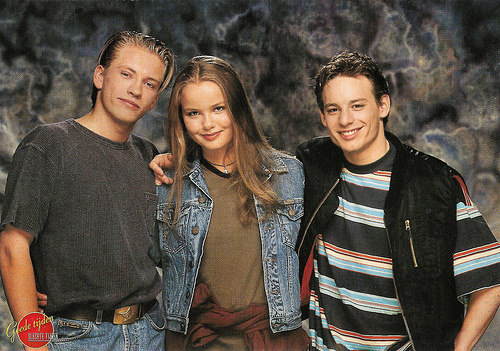
Dutch postcard in the GTST-verzamelkaarten series by Grundy / Joop van den Ende Productions / RTL4 / Veronica De Holland Media Group, no. 8. Photo: Govert de Roos. Publicity still for Goede Tijden Slechte Tijden/GTST with Ferri Somogyi and Angela Schijf.
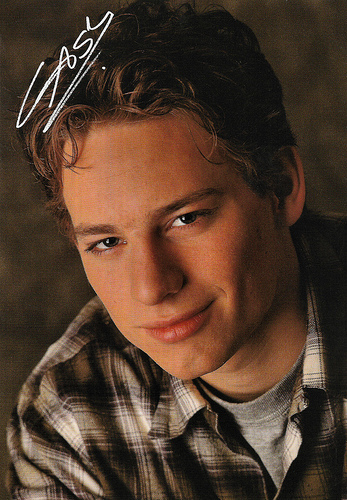
Dutch postcard in the GTST-verzamelkaarten series by RTL4, no. 10. Publicity still for Goede Tijden Slechte Tijden/GTST (1996-1999).
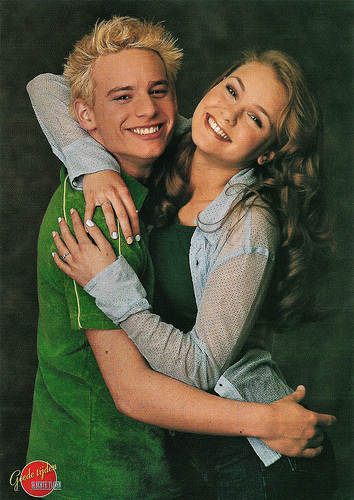
Dutch postcard in the GTST-verzamelkaarten series by Grundy / Joop van den Ende Productions / RTL4 / Veronica De Holland Media Group, no. 12. Photo: Govert de Roos. Publicity still for Goede Tijden Slechte Tijden/GTST (1996-1999) with Angela Schijf.

Dutch postcard in the GTST-verzamelkaarten series by Grundy / Joop van den Ende Productions / RTL4 / Veronica De Holland Media Group, no. 11. Photo: Govert de Roos. Publicity still for Goede Tijden Slechte Tijden/GTST (1996-1999) with Angela Schijf.
Sources: Wikipedia (Dutch and English), and .

Dutch postcard in the GTST-verzamelkaarten series by Grundy / Joop van den Ende Productions / RTL4 / Veronica De Holland Media Group / Entres / Photo Sportivo, no. 3. Photo: Govert de Roos. Publicity still for Goede Tijden Slechte Tijden/GTST (1996-1999) with Cas Jansen as Julian Verduyn.

Dutch postcard in the GTST-verzamelkaarten series by Grundy / Joop van den Ende Productions / RTL4 / Veronica De Holland Media Group / Entres / Photo Sportivo, no. 18. Photo: Govert de Roos. Publicity still for Goede Tijden Slechte Tijden/GTST (1996-1999) with Cas Jansen as Julian Verduyn.

Dutch postcard in the GTST-verzamelkaarten series by Grundy / Joop van den Ende Productions / RTL4 / Veronica De Holland Media Group / Entres / Photo Sportivo, no. 19. Photo: Govert de Roos. Publicity still for Goede Tijden Slechte Tijden/GTST (1996-1999) with Cas Jansen as Julian Verduyn.
Lord of the Flies
Cas Jansen was born Casper Jansen in 1977 in Badhoevedorp, the Netherlands.
At the age of 11, Jansen played on stage at Jeugd Theater De Krakeling in Amsterdam in the play Strandrand, a Dutch translation of Lord of the Flies by William Golding. He also appeared on stage in Ubu Roi (1993) and King Lear (1995).
In addition, Jansen played in several television series, including Fort Alpha (1996-1997). He became very popular with his role as Julian Verduyn in the TV soap Goede Tijden, Slechte Tijden/Good Times, Bad Times (1996-1999).
Then he got a small part in the film Karakter/Character (Mike van Diem, 1997), starring Fedja van Huêt and Jan Decleir. This film won the Oscar for Best Foreign Film.
Jansen was featured in the television series All Stars (1999-2001) as pot-head Nemo. His final breakthrough was the leading role as police officer Eddy Dolstra in the thriller Lek/Leak (Jean van de Velde, 2000), which won several Golden Calf awards, including for Best Feature.
For two seasons, he performed the role of detective Chris Luifel in the second season of the television series Luifel and Luifel (2002-2003). In this crime series his character solved murder cases with his father (Guus Dam).
Jansen then performed in the films Volle Maan/Full Moon Party (Johan Nijenhuis, 2002), and De Dominee/The Preacher (Gerrard Verhage, 2004), based on the life of gangster Klaas Bruinsma who was played by Peter Paul Muller.
Jansen played another supporting part in the Dutch action comedy Vet hard/Too Fat Too Furious (Tim Oliehoek, 2005), starring Jack Wouterse. This is a remake of the Danish comedy Gamle mænd i nye biler/Old Men in New Cars (Lasse Spang Olsen, 2002) and received a Golden Film for 100,000 visitors.

Dutch postcard by Boomerang, Amsterdam. Photo: Ray Christian / De Krom Studio. Artwork: Michiel van Randeraat/ Locust Enterainment. Promotion card for Volle Maan/Full Moon Party (Johan Nijenhuis, 2002) with Chantal Janzen.

Dutch postcard by Boomerang, Amsterdam. Photo: Ray Christian / De Krom Studio. Artwork: Michiel van Randeraat/ Locust Enterainment. Promotion card for Volle Maan/Full Moon Party (Johan Nijenhuis, 2002) with Daan Schuurmans.
A hellish ice skating tour
Cas Jansen tried to combine TV- and film roles with working in the theatre. In 2005, he acted on stage in d in the play Tape by Stephen Belber. In the 2006-2007 season, he performed a main role alongside Jelka van Houten in the play Sexual Perversity, directed by Marcus Azzini.
He voiced Emo in the short computer-animated film Elephants Dream (Bassam Kurdali, 2006). From 2006 till 2008, he played the leading role of Timo de Brauw in de TV series Spoorloos verdwenen/Vanished. In the summer of 2006, Jansen also made his debut as a radio DJ at the channel Caz!.
He played the leading role in the film De Hel van '63/The Hell of 63 (Steven de Jong, 2009) with Willeke van Ammelrooy. This film drama is based on the 1963 edition of the Elfstedentocht, a long distance ice skating tour in the Netherlands.
In 2010, he appeared on stage in the gangster opera Pimp with Nadja Hüpscher. and became the voice of the television channel Veronica. He returned as Nemo in the film All Stars 2: Old Stars (Jean van de Velde, 2011).
Cas Jansen is married since 2009 with actress Annelieke Bouwers, with whom he has a daughter and a son. He started to make family films like De Club van Lelijke Kinderen/The Ugly Kids Club (Jonathan Elbers, 2012), which won several awards, and the very popular Mees Kees (Barbara Bredero, 2012) starring Willem Voogd. He also appeared in the two sequels, Mees Kees op kamp/Mees Kees goes camping (Barbara Bredero, 2013) and Mees Kees op de planken/Mees kees on stage (Barbara Bredero, 2014).
Other films were Leve Boerenliefde/Live Farmers Love (Steven de Jong, 2013), and Wiplala (Tim Oliehoek, 2014), based on the classic children’s book by Annie M.G. Schmidt. In 2017 Cas Jansen appeared in the TV series Vaders & Moeders/Fathers & Mothers (Jelle de Jonge, 2012) with Anna Drijver, and De 12 van Oldenheim/The 12 of Oldenheim (Anne van der Linden, a.o., 2017), with Noortje Herlaar.

Dutch postcard in the GTST-verzamelkaarten series by Grundy / Joop van den Ende Productions / RTL4 / Veronica De Holland Media Group, no. 8. Photo: Govert de Roos. Publicity still for Goede Tijden Slechte Tijden/GTST with Ferri Somogyi and Angela Schijf.

Dutch postcard in the GTST-verzamelkaarten series by RTL4, no. 10. Publicity still for Goede Tijden Slechte Tijden/GTST (1996-1999).

Dutch postcard in the GTST-verzamelkaarten series by Grundy / Joop van den Ende Productions / RTL4 / Veronica De Holland Media Group, no. 12. Photo: Govert de Roos. Publicity still for Goede Tijden Slechte Tijden/GTST (1996-1999) with Angela Schijf.

Dutch postcard in the GTST-verzamelkaarten series by Grundy / Joop van den Ende Productions / RTL4 / Veronica De Holland Media Group, no. 11. Photo: Govert de Roos. Publicity still for Goede Tijden Slechte Tijden/GTST (1996-1999) with Angela Schijf.
Sources: Wikipedia (Dutch and English), and .
Published on February 11, 2018 22:00
February 10, 2018
Angela Similea
Romanian singer Angela Similea (1946) was one of the most famous Muzică ușoară (Romanian easy listening music) stars in the 1970s and 1980s. She also appeared in the popular Romanian film Rămăşagul (Ion Popescu Gopo, 1985).
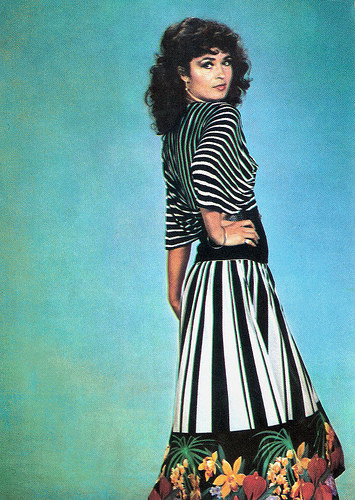
Romanian postcard by Casa Filmului Acin.
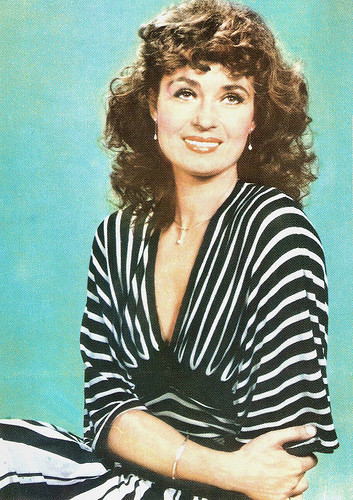
Romanian postcard by Casa Filmului Acin.
Smoking to get a less crystalline voice
Angela Similea was born in 1946 in the 1 Decembrie commune, Ilfov County, Romania. She was the oldest of the three children of Petre and Gherghina Similea.
As a child she was already attracted to music. Although she was very shy, she used to sing when she was travelling with the tram to the discomfort of her mother. As a teenager, she attended a concert by Maria Tanase, which inspired her to choose for a singing career.
However, her mother forced her to choose a ‘decent job,’ and to study to become a paediatrician. During high school, music teacher Marin Teofil discovered Angela’s singing talent, and spoke about it to the composer George Grigoriu, who then led the UTC ensemble.
She established that Angela could take singing lessons with Florica Orăscu. Orăscu worked with many other performers of Similea’s generation, such as Aura Urziceanu, Dida Dragan, and Olimpia Panciu.
Florica Orăscu believed that Similea had a ‘too crystalline’ voice, and recommended that she would start to smoke. After a relatively short period, Angela Similea's voice matured, descended and became deeper.
In 1965, she started to sing as an amateur, and obtained the third place in the amateur artists' festival. She sang V. Veselovski's song Câmpia sub lună (Plain under the Moon), which won the First Prize at a festival in Bucharest.
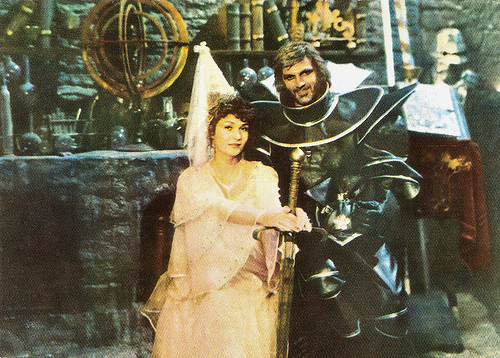
Romanian postcard by Casa Filmului Acin, no. 43 157. Publicity still for Rămăşagul (Ion Popescu Gopo, 1984) with Florin Persic .
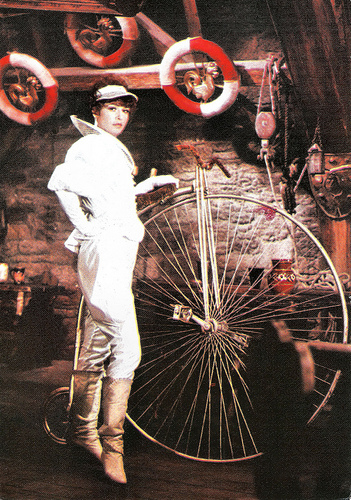
Romanian postcard by Casa Filmului Acin.
Dying from a wound of love
Angela Similea won many awards during the 1970s. Her first success was a second prize at the Cebul de Aur (Golden Stag) International Festival in 1970 where he won the Silver Deer. She made her TV debut in the show-contest Emoții (Emotions) where she sang the songs Așa ești tu (So you) and Guantanamera.
In 1971 she launched George Grigoriu’s song Amurgul, with which she won the special jury prize at the Ancora Decinului contest in Czechoslovakia. In 1972, she got the second place at the Golden Orpheus Festival in Bulgaria, with the song Tu ești primăvara mea (You are my spring) by Florin Bogardo. In 1977, the singer won the first prize at the Mamaia Festival for Un albastru infinit (Infinite Blue), composed by Marcel Dragomir.
In 1985 she appeared as a fairy in the film Rămăşagul (Ion Popescu Gopo, 1985), with the known Romanian film stars Iurie Darie and Florin Piersic . The film is based on the 19th century children's story Purse with Two Coins by the Romanian writer Ion Creanga.
Rămăşagul is a self-referential fantasy, complete with musical and animated interludes plus a cast of fairy-tale characters. It tells the story of an old man (Ion Lucian) who makes a bet with a fairy (Similea) that he can hide a bag with two golden coins from her for a week.
Throughout her career Similea managed to collaborate with some of the best Romanian composers, including Ion Cristinoiu, Marcel Dragomir, Marius Teicu and Zsolt Kerestely. In 2000, her song Să mori de dragoste rănită (To Die of Wounded Love), composed by Marcel Dragomir, on lyrics of Aurel Storin, was declared "the 20th century song" by the Romanian public during a TV gala.
After ten years of absence, Angela Similea returned to the music market in 2005 with a new album, entitled Lumea mea (My World). Angela Similea was married to politician Victor Surdu, who died in 2011. In 2014, Similea returned to the cinema in the comedy Scurt/4: Istorii de inimã neagrã (Andrei Cretulescu, Radu Jude, Luiza Parvu, Julia Rugina, 2014). She also appeared in the short film Sã mori de dragoste rãnitã/Dying from a wound of love (Iulia Rugina, 2014).
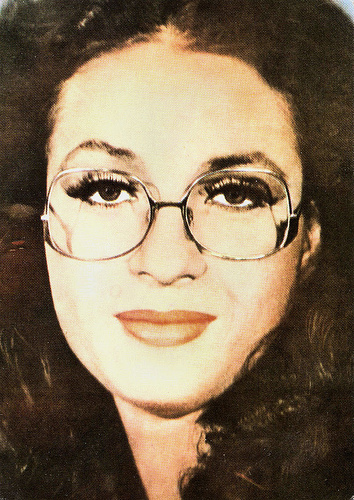
Romanian postcard by Casa Filmului Acin.
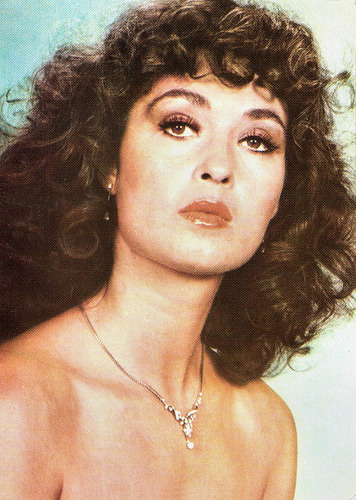
Romanian postcard by Casa Filmului Acin.
Angela Similea sings Casa mea. Source: raffaelo34 (YouTube).
Sources: Wikipedia (Romanian) and .

Romanian postcard by Casa Filmului Acin.

Romanian postcard by Casa Filmului Acin.
Smoking to get a less crystalline voice
Angela Similea was born in 1946 in the 1 Decembrie commune, Ilfov County, Romania. She was the oldest of the three children of Petre and Gherghina Similea.
As a child she was already attracted to music. Although she was very shy, she used to sing when she was travelling with the tram to the discomfort of her mother. As a teenager, she attended a concert by Maria Tanase, which inspired her to choose for a singing career.
However, her mother forced her to choose a ‘decent job,’ and to study to become a paediatrician. During high school, music teacher Marin Teofil discovered Angela’s singing talent, and spoke about it to the composer George Grigoriu, who then led the UTC ensemble.
She established that Angela could take singing lessons with Florica Orăscu. Orăscu worked with many other performers of Similea’s generation, such as Aura Urziceanu, Dida Dragan, and Olimpia Panciu.
Florica Orăscu believed that Similea had a ‘too crystalline’ voice, and recommended that she would start to smoke. After a relatively short period, Angela Similea's voice matured, descended and became deeper.
In 1965, she started to sing as an amateur, and obtained the third place in the amateur artists' festival. She sang V. Veselovski's song Câmpia sub lună (Plain under the Moon), which won the First Prize at a festival in Bucharest.

Romanian postcard by Casa Filmului Acin, no. 43 157. Publicity still for Rămăşagul (Ion Popescu Gopo, 1984) with Florin Persic .

Romanian postcard by Casa Filmului Acin.
Dying from a wound of love
Angela Similea won many awards during the 1970s. Her first success was a second prize at the Cebul de Aur (Golden Stag) International Festival in 1970 where he won the Silver Deer. She made her TV debut in the show-contest Emoții (Emotions) where she sang the songs Așa ești tu (So you) and Guantanamera.
In 1971 she launched George Grigoriu’s song Amurgul, with which she won the special jury prize at the Ancora Decinului contest in Czechoslovakia. In 1972, she got the second place at the Golden Orpheus Festival in Bulgaria, with the song Tu ești primăvara mea (You are my spring) by Florin Bogardo. In 1977, the singer won the first prize at the Mamaia Festival for Un albastru infinit (Infinite Blue), composed by Marcel Dragomir.
In 1985 she appeared as a fairy in the film Rămăşagul (Ion Popescu Gopo, 1985), with the known Romanian film stars Iurie Darie and Florin Piersic . The film is based on the 19th century children's story Purse with Two Coins by the Romanian writer Ion Creanga.
Rămăşagul is a self-referential fantasy, complete with musical and animated interludes plus a cast of fairy-tale characters. It tells the story of an old man (Ion Lucian) who makes a bet with a fairy (Similea) that he can hide a bag with two golden coins from her for a week.
Throughout her career Similea managed to collaborate with some of the best Romanian composers, including Ion Cristinoiu, Marcel Dragomir, Marius Teicu and Zsolt Kerestely. In 2000, her song Să mori de dragoste rănită (To Die of Wounded Love), composed by Marcel Dragomir, on lyrics of Aurel Storin, was declared "the 20th century song" by the Romanian public during a TV gala.
After ten years of absence, Angela Similea returned to the music market in 2005 with a new album, entitled Lumea mea (My World). Angela Similea was married to politician Victor Surdu, who died in 2011. In 2014, Similea returned to the cinema in the comedy Scurt/4: Istorii de inimã neagrã (Andrei Cretulescu, Radu Jude, Luiza Parvu, Julia Rugina, 2014). She also appeared in the short film Sã mori de dragoste rãnitã/Dying from a wound of love (Iulia Rugina, 2014).

Romanian postcard by Casa Filmului Acin.

Romanian postcard by Casa Filmului Acin.
Angela Similea sings Casa mea. Source: raffaelo34 (YouTube).
Sources: Wikipedia (Romanian) and .
Published on February 10, 2018 22:00
February 9, 2018
Neue Photographische Gesellschaft
The first German publishers of film star postcards were Verlag Hermann Leiser, Photochemie, Rotophot with its Film Sterne series and NPG. NPG stands for Neue Photographische Gesellschaft (New Photographic Society). Between 1897 and 1921, NPG was located in the Siemensstrasse in Berlin. There, the 1200 employees produced thousands and thousands of postcards, photos and stereograms. The film star postcards are only a limited part of this enormous production. But what a delicious part!
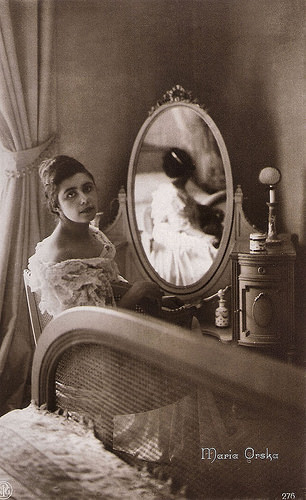
Maria Orska . German postcard by NPG, no. 276.
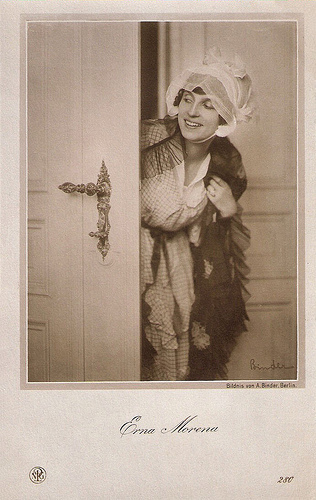
Erna Morena . German postcard by NPG, no. 280. Photo: Alex Binder, Berlin.
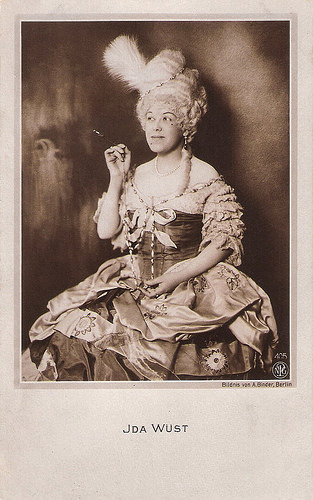
Ida Wüst . German postcard by NPG, no. 405. Photo: Alex Binder, Berlin.
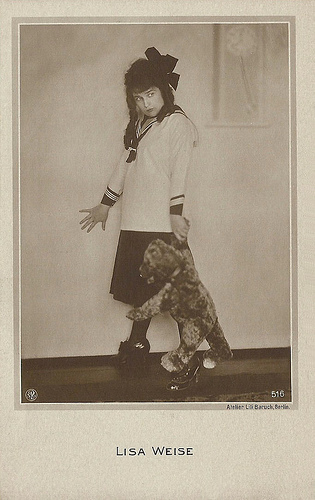
Lisa Weise . German postcard by NPG, no. 516. Photo: Lili Baruch, Berlin. Collection: Didier Hanson.
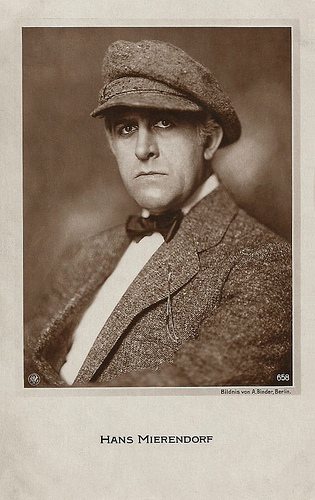
Hans Mierendorff . German postcard by NPG, no. 658. Photo: Alex Binder, Berlin.
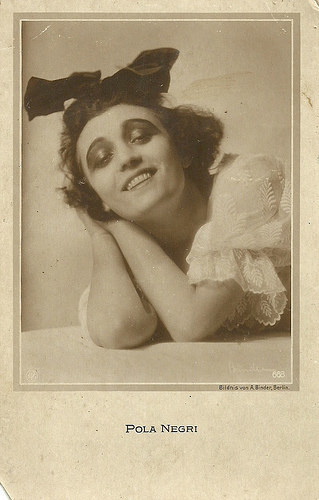
Pola Negri . German postcard by NPG, no. 668. Photo: Alex Binder, Berlin.
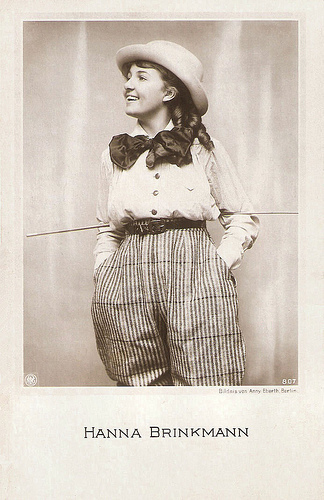
Hanne Brinkmann . German postcard by NPG, no. 807. Photo: Anny Eberth, Berlin.
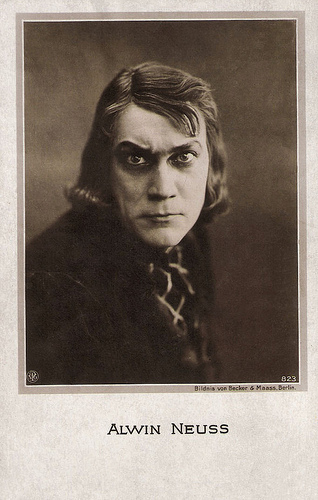
Alwin Neuss . German postcard by NPG, no. 823. Photo: Becker & Maass, Berlin.
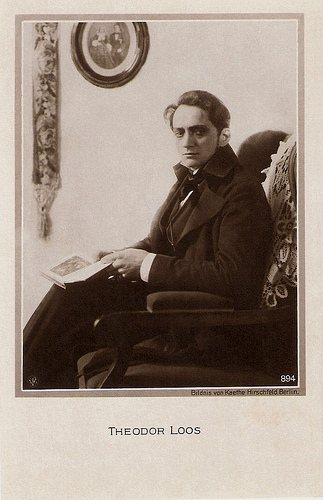
Theodor Loos . German postcard by NPG, no. 894. Photo: Käthe Hirschfeld, Berlin.
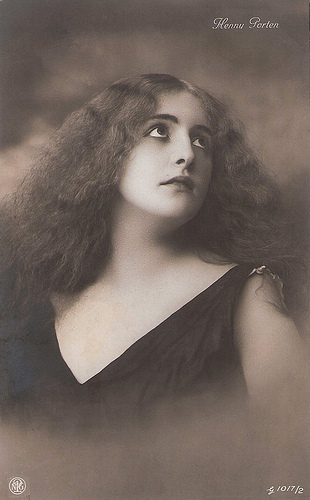
Henny Porten . German postcard by NPG, no. G 1017/2.
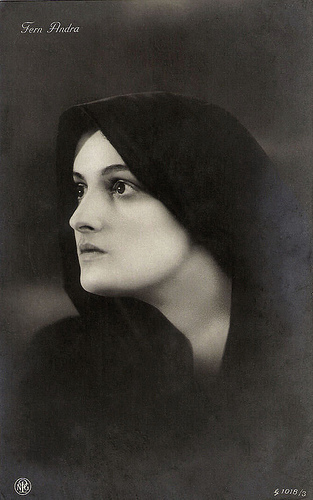
Fern Andra . German postcard by NPG, no. G 1018/3.
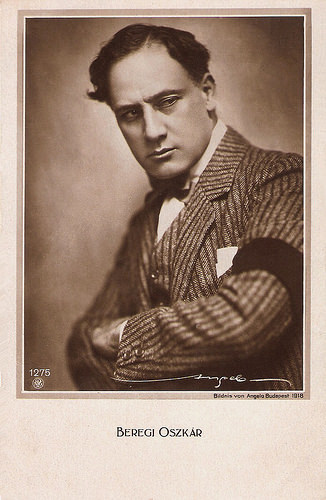
Oscar Beregi Sr. German postcard by NPG, no. 1275 Photo: Angelo, Budapest, 1918.
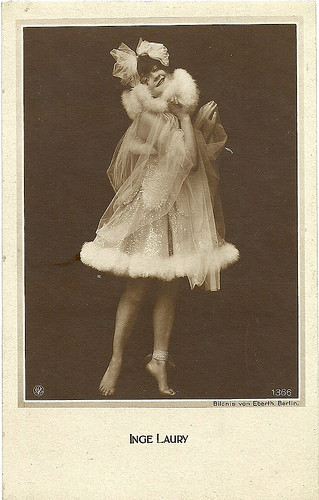
Inge Laury. German postcard by NPG, no. 1366. Photo: Eberth, Berlin. Collection: Didier Hanson.
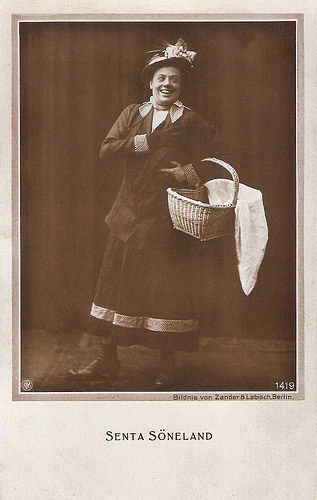
Senta Söneland . German postcard by NPG, no. 1419. Photo: Zander & Labisch, Berlin.
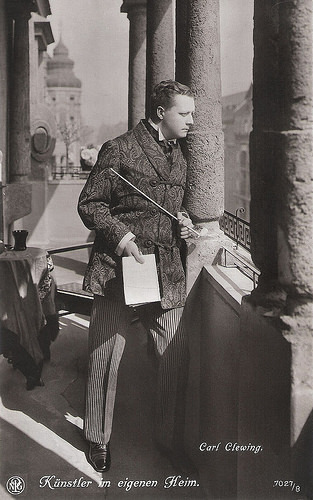
Carl Clewing . German postcard by NPG, no. 7027/8. Caption: "Künstler im eigenen Heim" (The artist at his own home).
Sources: Mark Goffee (Ross Postcards) and Wikipedia (German).

Maria Orska . German postcard by NPG, no. 276.

Erna Morena . German postcard by NPG, no. 280. Photo: Alex Binder, Berlin.

Ida Wüst . German postcard by NPG, no. 405. Photo: Alex Binder, Berlin.

Lisa Weise . German postcard by NPG, no. 516. Photo: Lili Baruch, Berlin. Collection: Didier Hanson.

Hans Mierendorff . German postcard by NPG, no. 658. Photo: Alex Binder, Berlin.

Pola Negri . German postcard by NPG, no. 668. Photo: Alex Binder, Berlin.

Hanne Brinkmann . German postcard by NPG, no. 807. Photo: Anny Eberth, Berlin.

Alwin Neuss . German postcard by NPG, no. 823. Photo: Becker & Maass, Berlin.

Theodor Loos . German postcard by NPG, no. 894. Photo: Käthe Hirschfeld, Berlin.

Henny Porten . German postcard by NPG, no. G 1017/2.

Fern Andra . German postcard by NPG, no. G 1018/3.

Oscar Beregi Sr. German postcard by NPG, no. 1275 Photo: Angelo, Budapest, 1918.

Inge Laury. German postcard by NPG, no. 1366. Photo: Eberth, Berlin. Collection: Didier Hanson.

Senta Söneland . German postcard by NPG, no. 1419. Photo: Zander & Labisch, Berlin.

Carl Clewing . German postcard by NPG, no. 7027/8. Caption: "Künstler im eigenen Heim" (The artist at his own home).
Sources: Mark Goffee (Ross Postcards) and Wikipedia (German).
Published on February 09, 2018 22:00
February 8, 2018
Anna Müller-Lincke
Anna Müller-Lincke (1869-1935) was a German soubrette and stage and screen actress. Earning herself the sobriquet 'Königin des Humors' (Queen of Humour), she performed on stage in Berlin and later conducted successful tours of Europe and the Americas. For a while, she had her own film company, Anna Müller-Lincke-Film, and she was popular enough to start a whole series of comedies with her character Anna.
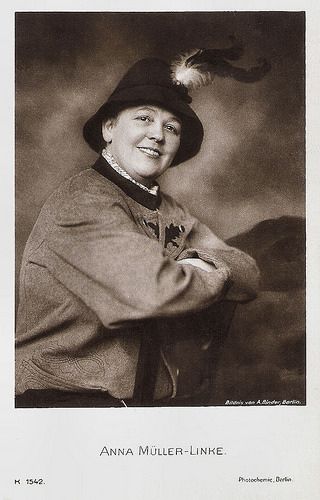
German postcard by Photochemie, Berlin, no. K. 1542. Photo: Alex Binder, Berlin.
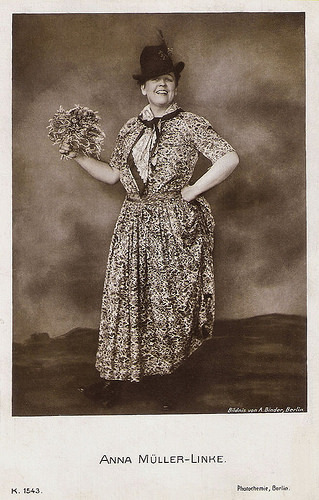
German postcard by Photochemie, Berlin, no. K. 1543. Photo: Alex Binder, Berlin.
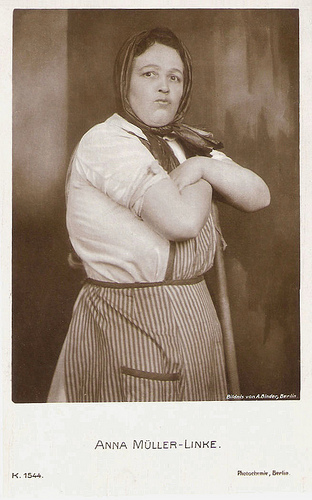
German postcard by Photochemie, Berlin, no. K. 1544. Photo: Alex Binder, Berlin.
A well-known soubrette
Anna Müller-Lincke was born Anna Marie Louise Waldmüller (according to some sources: Müller) in Berlin in 1869. Already at the age of four, she made her stage debut at the Nationaltheater in Berlin. She performed with her sister Ida, who was seven years her senior,
As a teenager, she had singing lessons from the opera singer Mathilde Mallinger. Anna soon became a well-known soubrette and also stage actress. Only 16, she played in the Ostend Theater in Berlin in the Gross-Frankfurter Straße, later known as the Rose Theater.
At the Ostend Theater, she met in 1885 the then 19-year-old bassoonist Paul Lincke. In 1893 (some sources say 1886), they married and from then on Anna acted under the name Anna Müller-Lincke. Paul Lincke later celebrated triumphs as an operetta composer and went down in history as the 'father of the Berlin operetta'. In 1898 (some sources say 1901) the couple divorced again. Reportedly, the turbulent separation was the result of an affair by Paul Lincke, when he worked in Paris as the chef of the orchestra at the Folies Bergères.
Anna Müller-Lincke had a brilliant stage career. She performed at the Victoria Theater, the Belle Alliance Theater, the Central Theater, the Adolf Ernst Theater and seven years at the prestigious Metropol Theater and Lessing Theater. Performances took her to France, Holland, Denmark, Russia and North and South America.
Already in 1907, Anna Müller-Lincke performed as singer in two early sound films (Tonbilder) for the Deutsche Bioskop: Abends nach Neune: Duett aus Durchlaucht Radieschen. Nr. 11, and Roland und Viktoria: Duett aus "Neuestes! Allerneuestes!". Nr. 10, both sung with Leonhard Haskel. It was then a daring step to try to gain a foothold in the disapproved-of film business.
In 1910, the courageous Müller-Lincke appeared for Messter-Film in her first silent fiction film, Bundrika, die Negerköchin/Bundrika the Negro Cook, but it was only from 1913 that she had a steady career in German silent cinema. Initially, she appeared in hearty roles (cooks, maids, resolute widows), latterly as dowagers and little old ladies.
In 1913, she appeared in such films as Zwei Tage im Paradies/Tow days in paradise (Danny Kaden, 1913), Die Firma heiratet/The Firm Gets Married (Carl Wilhelm, 1913) starring Ernst Lubitsch , and the hit comedy Wo ist Coletti/Where Is Coletti? (Max Mack 1913) with Hans Junkermann.
During the First World War, she appeared in Die Marketenderin/The sutler (Carl Wilhelm, 1914), Hans und Hanni/Hans and Hanni (Max Mack, 1914) with Hanni Weisse , Frau Annas Pilgerfahrt/Mrs. Anna's pilgrimage (Carl Wilhelm, 1915), Musketier Kaczmarek/Musketeer Kaczmarek (Carl Froehlich, 1915), Zofenstreiche/Maid sweep (Hubert Moest, 1915) with Hedda Vernon , Hampels Abenteuer/Hampel's Adventures (Richard Oswald, 1915), and Vom Regen in die Traufe/From the rain in the eaves (Emil Albes, Einar Bruun, 1917).
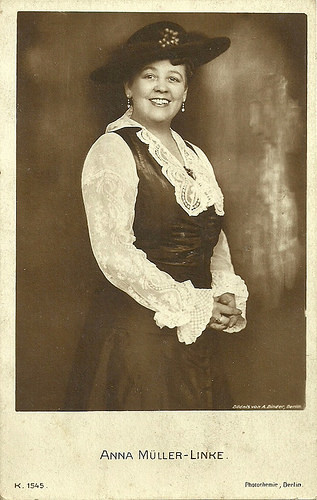
German postcard by Photochemie, Berlin, no. K. 1545. Photo: A. Binder, Berlin.
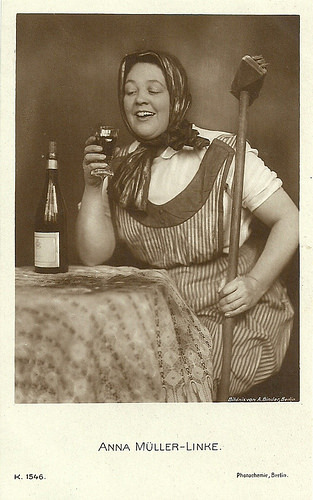
German postcard by Photochemie, Berlin, no. K. 1546. Photo: A. Binder, Berlin.
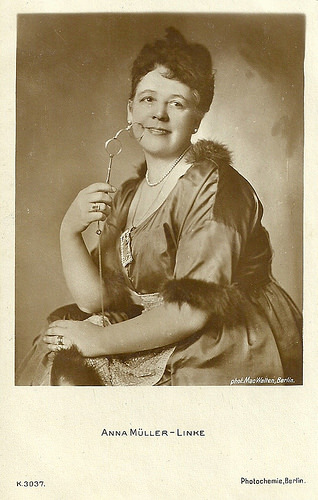
German postcard by Photochemie, Berlin, no. K. 3837. Photo: MacWalten, Berlin.
Anna-comedies
In 1917, Anna Müller-Lincke founded her own company Anna Müller-Lincke-Film, for which she produced Die linkische Anna (1917). Though her company was short lived Lincke was popular enough to start a whole series with her character Anna: Rechtsanwalt Anna/Lawyer Anna (1917), Anna Müller-Lincke kandidiert/Anna Müller-Lincke is running (Werner Sinn, 1919), Anna mit'n Flimmerfimmel/Anna with the flicker fool (Charley Mettinger, 1919).
In 1919-1920, Lincke was productive with four to five some films per year. While Lincke worked for all kinds of companies, in 1919-1920 she did various films for DLG (Deutsche Lichtbild-Gesellschaft) such as Margots Freier/Margot's suitor (Hans Werckmeister, 1919).
By 1921 the vogue of the Anna-comedies was over and Lincke had to be content with supporting parts in dramas and comedies. After a gap in 1922-1923, she returned in commercials in 1924 and supporting parts in fiction from 1925, such as Sündenbabel/Den of Iniquity (Constantin J. David, 1925) with Reinhold Schünzel , Was eine Frau im Frühling träumt/What a Woman Dreams of in Springtime (Curt Blachnitzky, 1928-1929), Kehre zurück! Alles vergeben!/Come Back, All Is Forgiven (Erich Schönfelder, 1929) with Dina Gralla , and Lumpenball/Rags ball (Carl Heinz Wolff, 1930).
Thanks to her song and stage career, Anna Müller-Lincke easily switched to sound film. She could be seen in such early sound films as Die große Sehnsucht/The Great Longing (István Székely, 1930) with Theodor Loos and Camilla Horn , Der wahre Jakob/The true Jacob (Hans Steinhoff, 1930-31) – in which Müller-Lincke even had the lead - and the Alfred Döblin adaptation Berlin–Alexanderplatz (Phil Jutzi, 1931) with Heinrich George as Franz Biberkopf.
Her repertory ranged from a bit part in the communist film Kuhle Wampe oder Wem gehört die Welt?/To Whom Does the World Belong? (Slatan Dudow, 1932) with Hertha Thiele , to another bit part in the fascist film Hitlerjunge Quex/Our Flag Leads Us Forward (Hans Steinhoff, 1933) with Heinrich George .
In addition to various, uncredited bit parts in the early 1930s, more substantial parts followed for Müller-Lincke in e.g. Die blonde Nachtigall/The Blonde Nightingale (Johannes Meyer, 1930) and the shorts Der Herr von nebenan/The gentleman next door (Rolf Randolf, 1933), Carlos schönste Abenteuer/Carlo's most beautiful adventure (Phil Jutzi, 1934) with Carlo Aldini , and Ferner liefen/Further ran (Phil Jutzi, 1934).
Anna Müller-Lincke died in Berlin in 1935. She was 66, and she had worked on till shortly before her death.
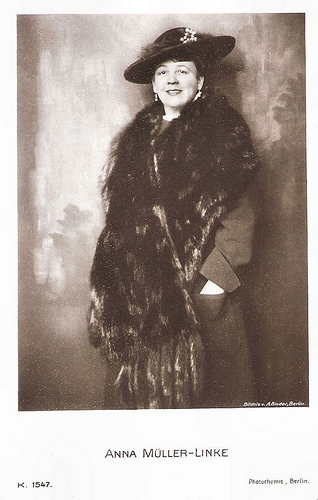
German postcard by Photochemie, Berlin, no. K. 1547. Photo: Alex Binder, Berlin.
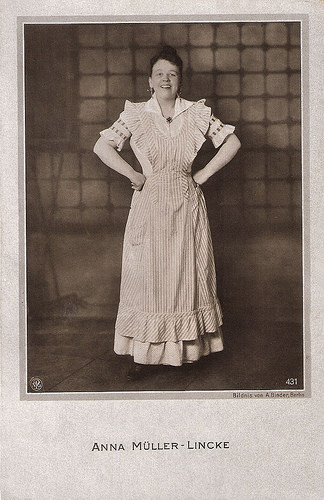
German postcard by NPG, no. 431. Photo: Alex Binder, Berlin.
Sources: Stephanie D'heil (Steffi-Line - German), Filmportal.de, Wikipedia (German and English) and .

German postcard by Photochemie, Berlin, no. K. 1542. Photo: Alex Binder, Berlin.

German postcard by Photochemie, Berlin, no. K. 1543. Photo: Alex Binder, Berlin.

German postcard by Photochemie, Berlin, no. K. 1544. Photo: Alex Binder, Berlin.
A well-known soubrette
Anna Müller-Lincke was born Anna Marie Louise Waldmüller (according to some sources: Müller) in Berlin in 1869. Already at the age of four, she made her stage debut at the Nationaltheater in Berlin. She performed with her sister Ida, who was seven years her senior,
As a teenager, she had singing lessons from the opera singer Mathilde Mallinger. Anna soon became a well-known soubrette and also stage actress. Only 16, she played in the Ostend Theater in Berlin in the Gross-Frankfurter Straße, later known as the Rose Theater.
At the Ostend Theater, she met in 1885 the then 19-year-old bassoonist Paul Lincke. In 1893 (some sources say 1886), they married and from then on Anna acted under the name Anna Müller-Lincke. Paul Lincke later celebrated triumphs as an operetta composer and went down in history as the 'father of the Berlin operetta'. In 1898 (some sources say 1901) the couple divorced again. Reportedly, the turbulent separation was the result of an affair by Paul Lincke, when he worked in Paris as the chef of the orchestra at the Folies Bergères.
Anna Müller-Lincke had a brilliant stage career. She performed at the Victoria Theater, the Belle Alliance Theater, the Central Theater, the Adolf Ernst Theater and seven years at the prestigious Metropol Theater and Lessing Theater. Performances took her to France, Holland, Denmark, Russia and North and South America.
Already in 1907, Anna Müller-Lincke performed as singer in two early sound films (Tonbilder) for the Deutsche Bioskop: Abends nach Neune: Duett aus Durchlaucht Radieschen. Nr. 11, and Roland und Viktoria: Duett aus "Neuestes! Allerneuestes!". Nr. 10, both sung with Leonhard Haskel. It was then a daring step to try to gain a foothold in the disapproved-of film business.
In 1910, the courageous Müller-Lincke appeared for Messter-Film in her first silent fiction film, Bundrika, die Negerköchin/Bundrika the Negro Cook, but it was only from 1913 that she had a steady career in German silent cinema. Initially, she appeared in hearty roles (cooks, maids, resolute widows), latterly as dowagers and little old ladies.
In 1913, she appeared in such films as Zwei Tage im Paradies/Tow days in paradise (Danny Kaden, 1913), Die Firma heiratet/The Firm Gets Married (Carl Wilhelm, 1913) starring Ernst Lubitsch , and the hit comedy Wo ist Coletti/Where Is Coletti? (Max Mack 1913) with Hans Junkermann.
During the First World War, she appeared in Die Marketenderin/The sutler (Carl Wilhelm, 1914), Hans und Hanni/Hans and Hanni (Max Mack, 1914) with Hanni Weisse , Frau Annas Pilgerfahrt/Mrs. Anna's pilgrimage (Carl Wilhelm, 1915), Musketier Kaczmarek/Musketeer Kaczmarek (Carl Froehlich, 1915), Zofenstreiche/Maid sweep (Hubert Moest, 1915) with Hedda Vernon , Hampels Abenteuer/Hampel's Adventures (Richard Oswald, 1915), and Vom Regen in die Traufe/From the rain in the eaves (Emil Albes, Einar Bruun, 1917).

German postcard by Photochemie, Berlin, no. K. 1545. Photo: A. Binder, Berlin.

German postcard by Photochemie, Berlin, no. K. 1546. Photo: A. Binder, Berlin.

German postcard by Photochemie, Berlin, no. K. 3837. Photo: MacWalten, Berlin.
Anna-comedies
In 1917, Anna Müller-Lincke founded her own company Anna Müller-Lincke-Film, for which she produced Die linkische Anna (1917). Though her company was short lived Lincke was popular enough to start a whole series with her character Anna: Rechtsanwalt Anna/Lawyer Anna (1917), Anna Müller-Lincke kandidiert/Anna Müller-Lincke is running (Werner Sinn, 1919), Anna mit'n Flimmerfimmel/Anna with the flicker fool (Charley Mettinger, 1919).
In 1919-1920, Lincke was productive with four to five some films per year. While Lincke worked for all kinds of companies, in 1919-1920 she did various films for DLG (Deutsche Lichtbild-Gesellschaft) such as Margots Freier/Margot's suitor (Hans Werckmeister, 1919).
By 1921 the vogue of the Anna-comedies was over and Lincke had to be content with supporting parts in dramas and comedies. After a gap in 1922-1923, she returned in commercials in 1924 and supporting parts in fiction from 1925, such as Sündenbabel/Den of Iniquity (Constantin J. David, 1925) with Reinhold Schünzel , Was eine Frau im Frühling träumt/What a Woman Dreams of in Springtime (Curt Blachnitzky, 1928-1929), Kehre zurück! Alles vergeben!/Come Back, All Is Forgiven (Erich Schönfelder, 1929) with Dina Gralla , and Lumpenball/Rags ball (Carl Heinz Wolff, 1930).
Thanks to her song and stage career, Anna Müller-Lincke easily switched to sound film. She could be seen in such early sound films as Die große Sehnsucht/The Great Longing (István Székely, 1930) with Theodor Loos and Camilla Horn , Der wahre Jakob/The true Jacob (Hans Steinhoff, 1930-31) – in which Müller-Lincke even had the lead - and the Alfred Döblin adaptation Berlin–Alexanderplatz (Phil Jutzi, 1931) with Heinrich George as Franz Biberkopf.
Her repertory ranged from a bit part in the communist film Kuhle Wampe oder Wem gehört die Welt?/To Whom Does the World Belong? (Slatan Dudow, 1932) with Hertha Thiele , to another bit part in the fascist film Hitlerjunge Quex/Our Flag Leads Us Forward (Hans Steinhoff, 1933) with Heinrich George .
In addition to various, uncredited bit parts in the early 1930s, more substantial parts followed for Müller-Lincke in e.g. Die blonde Nachtigall/The Blonde Nightingale (Johannes Meyer, 1930) and the shorts Der Herr von nebenan/The gentleman next door (Rolf Randolf, 1933), Carlos schönste Abenteuer/Carlo's most beautiful adventure (Phil Jutzi, 1934) with Carlo Aldini , and Ferner liefen/Further ran (Phil Jutzi, 1934).
Anna Müller-Lincke died in Berlin in 1935. She was 66, and she had worked on till shortly before her death.

German postcard by Photochemie, Berlin, no. K. 1547. Photo: Alex Binder, Berlin.

German postcard by NPG, no. 431. Photo: Alex Binder, Berlin.
Sources: Stephanie D'heil (Steffi-Line - German), Filmportal.de, Wikipedia (German and English) and .
Published on February 08, 2018 22:00
February 7, 2018
Aux yeux du souvenir (1948)
The romantic drama Aux yeux du souvenir/Nightstop in Dakar (Jean Delannoy, 1948) starred two of the most beautiful and unforgettable stars of the French cinema, Michèle Morgan and Jean Marais. The screenplay was written by director Delannoy, Henri Jeanson and Georges Neveux. At the 1949 Venice Film Festival, Jean Delannoy was nominated for a Golden Lion.
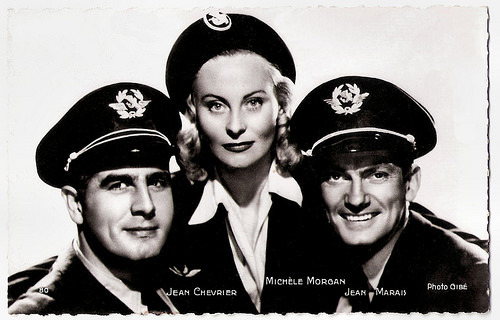
French postcard by Editions P.I., offered by Les Carbones Korès, no. 80. Photo: Qibé. Publicity still for Aux yeux du souvenir/Nightstop in Dakar (Jean Delannoy, 1948) with Jean Chevrier , Michèle Morgan and Jean Marais .
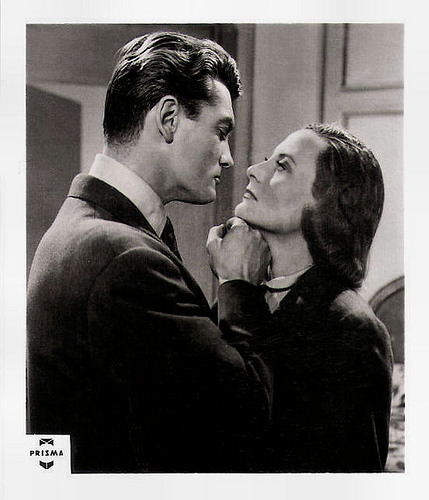
German collectors card. Photo: Prisma. Publicity still for Aux yeux du souvenir/Nightstop in Dakar (Jean Delannoy, 1948).
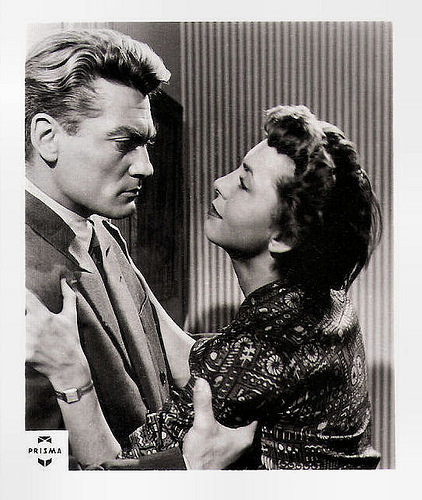
German collectors card. Photo: Prisma. Publicity still for Aux yeux du souvenir/Nightstop in Dakar (Jean Delannoy, 1948).
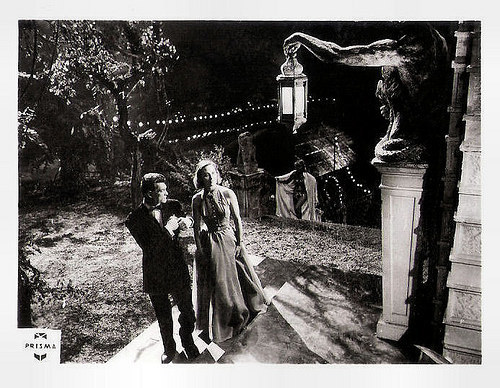
German collectors card. Photo: Prisma. Publicity still for Aux yeux du souvenir/Nightstop in Dakar (Jean Delannoy, 1948).
Harlequin Romance
In Aux yeux du souvenir (1948), Michèle Morgan plays Claire Magny, who wanted to be a stage actress, but became an air hostess after an unhappy love affair.
Claire is to marry commandant Pierre Aubry ( Jean Chevrier ) when Jacques Forestier ( Jean Marais ), a former love, reappears in her life.
Thanks to Pierre's support, Jacques becomes an airline pilot. During a dramatic flight, Jacques manages to save his plane. Claire realises she is still in love with Jacques. But she is Pierre's fiancee...
The end of the film is inspired by a real event accomplished above the Atlantic ocean on the 7 February 1947 by an Air France crew member.
D.B. DuMonteil at IMDb calls the film 'weak': "Although it features Delannoy 's favorite actress, Michèle Morgan and Jean Marais , perhaps the most attractive couple of the era. Made at a time French people would not take planes, Morgan as an air hostess, and Marais as an airline pilot could easily make a young girls dream. It also glorified Air France. A good writer such as Henri Jeanson could not save a conventional love story, which resembles a Harlequin romance."
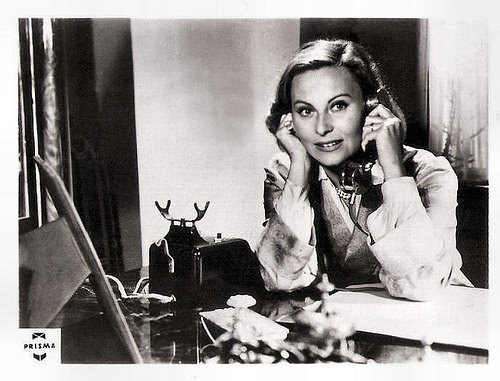
German collectors card. Photo: Prisma. Publicity still for Aux yeux du souvenir/Nightstop in Dakar (Jean Delannoy, 1948).
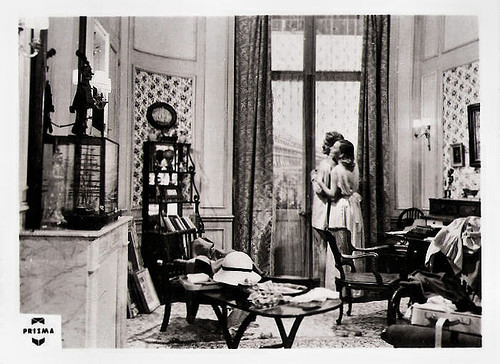
German collectors card. Photo: Prisma. Publicity still for Aux yeux du souvenir/Nightstop in Dakar (Jean Delannoy, 1948).
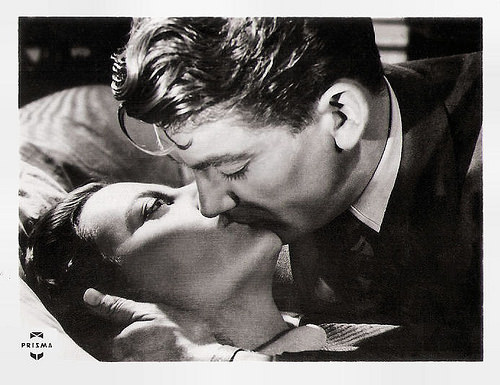
German collectors card. Photo: Prisma. Publicity still for Aux yeux du souvenir/Nightstop in Dakar (Jean Delannoy, 1948).
Sources: D.B. DuMonteil (IMDb), Wikipedia and IMDb.

French postcard by Editions P.I., offered by Les Carbones Korès, no. 80. Photo: Qibé. Publicity still for Aux yeux du souvenir/Nightstop in Dakar (Jean Delannoy, 1948) with Jean Chevrier , Michèle Morgan and Jean Marais .

German collectors card. Photo: Prisma. Publicity still for Aux yeux du souvenir/Nightstop in Dakar (Jean Delannoy, 1948).

German collectors card. Photo: Prisma. Publicity still for Aux yeux du souvenir/Nightstop in Dakar (Jean Delannoy, 1948).

German collectors card. Photo: Prisma. Publicity still for Aux yeux du souvenir/Nightstop in Dakar (Jean Delannoy, 1948).
Harlequin Romance
In Aux yeux du souvenir (1948), Michèle Morgan plays Claire Magny, who wanted to be a stage actress, but became an air hostess after an unhappy love affair.
Claire is to marry commandant Pierre Aubry ( Jean Chevrier ) when Jacques Forestier ( Jean Marais ), a former love, reappears in her life.
Thanks to Pierre's support, Jacques becomes an airline pilot. During a dramatic flight, Jacques manages to save his plane. Claire realises she is still in love with Jacques. But she is Pierre's fiancee...
The end of the film is inspired by a real event accomplished above the Atlantic ocean on the 7 February 1947 by an Air France crew member.
D.B. DuMonteil at IMDb calls the film 'weak': "Although it features Delannoy 's favorite actress, Michèle Morgan and Jean Marais , perhaps the most attractive couple of the era. Made at a time French people would not take planes, Morgan as an air hostess, and Marais as an airline pilot could easily make a young girls dream. It also glorified Air France. A good writer such as Henri Jeanson could not save a conventional love story, which resembles a Harlequin romance."

German collectors card. Photo: Prisma. Publicity still for Aux yeux du souvenir/Nightstop in Dakar (Jean Delannoy, 1948).

German collectors card. Photo: Prisma. Publicity still for Aux yeux du souvenir/Nightstop in Dakar (Jean Delannoy, 1948).

German collectors card. Photo: Prisma. Publicity still for Aux yeux du souvenir/Nightstop in Dakar (Jean Delannoy, 1948).
Sources: D.B. DuMonteil (IMDb), Wikipedia and IMDb.
Published on February 07, 2018 22:00
February 6, 2018
Paulette Dubost
French star Paulette Dubost (1910-2011) appeared in more than 150 films during her 81 year career. She was a witty, naughty and clever comedienne in many French comedies of the 1930s. She also proved to be good in dramatic roles, such as Ginette in Hotel du Nord (1938) and Lisette in La règle du jeu (1939).
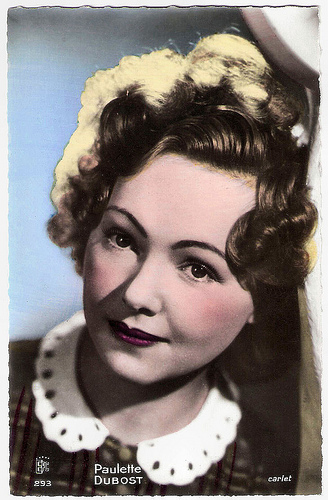
French postcard by Editions et Publications Cinématographiques (EPC), no. 293. Photo: Carlet.
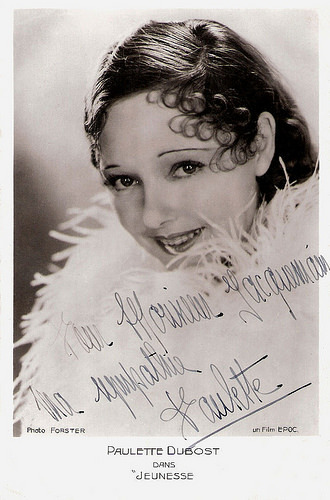
French autograph card. Photo: Forster / Film EPOC. Publicity still for Jeunesse/Youth (Georges Lacombe, 1933).
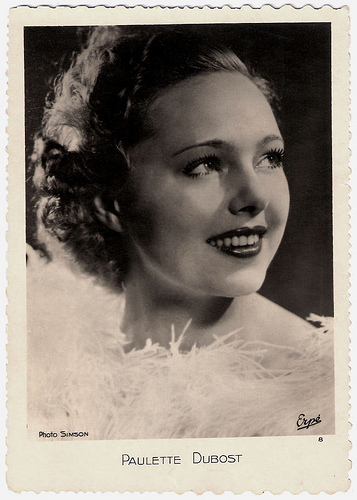
French postcard by Erpé, no. 8. Photo: Simson.
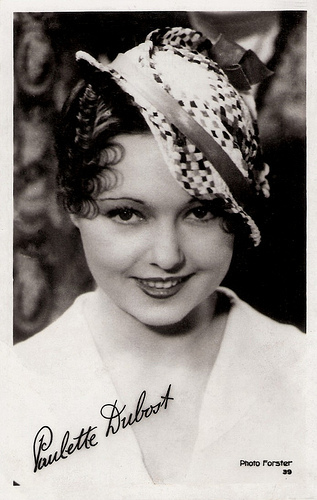
French postcard, no. 39. Photo: Forster.
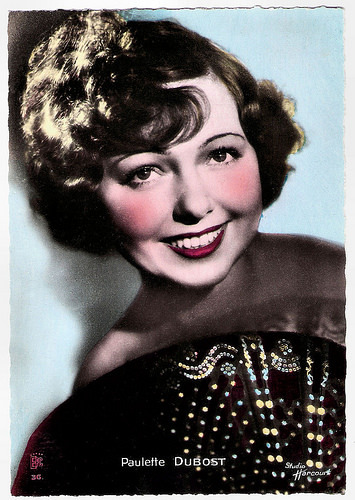
French postcard by EPC, no. 36. Photo: Studio Harcourt.
Great Classics
Paulette Dubost was born Paulette Marie Emma Deplanque in Paris, France, in 1910. Her father was a gas engineer and her mother a singer at the Opéra Comique.
Paulette began her career at the age of 7 at the Opéra de Paris. At 17, she switched to operetta and played for two years in Les Aventures du roi Pausole (The Adventures of King Pausole) at the Bouffes Parisiens with Simone Simon , Edwige Feuillère and Viviane Romance .
Her naughty look and her voice were quickly noticed by the cinema, and from 1930 on she played roles in films by Jacques Tourneur, Jean Renoir, Andre Cayatte, Gilles Grangier and Max Ophuls.
In Le roi des Champs-Élysées/The King of the Champs Elysees (Max Nosseck, 1935), she appeared opposite the famous silent film star Buster Keaton in a dual role.
Dubost played a supporting part in Hotel du Nord/North Hotel (1936), starring Annabella and Jean-Pierre Aumont . It was the second of Marcel Carné's trio of 'fatalistic romantic melodramas'.
Her most famous film from this period is Jean Renoir's La Règle du jeu/Rules of the Game (1939). Though it's now regarded as one of the great classics of the French film, it was not warmly received on its original release in 1939.
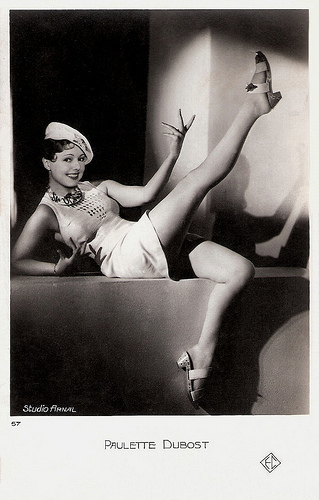
French postcard by EC, no. 57. Photo: Studio Arnal.
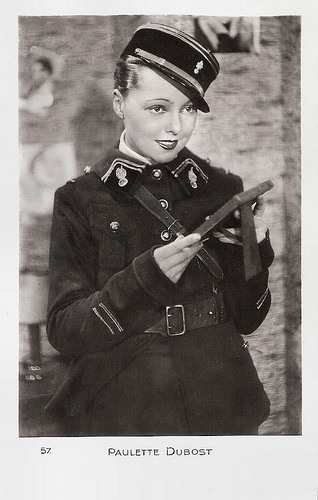
French autograph card, no. 57. Photo: publicity still for La caserne en folie/The barracks in madness (Maurice Cammage, 1935).
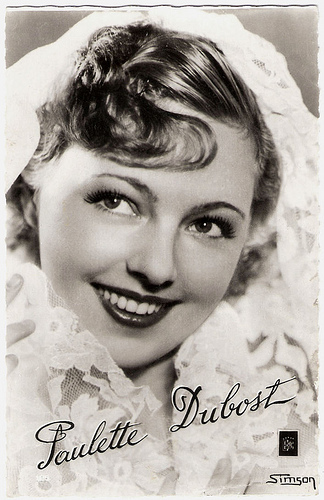
French postcard by Editions et Publications Cinématographiques (EPC), no. 125. Photo: Simson.
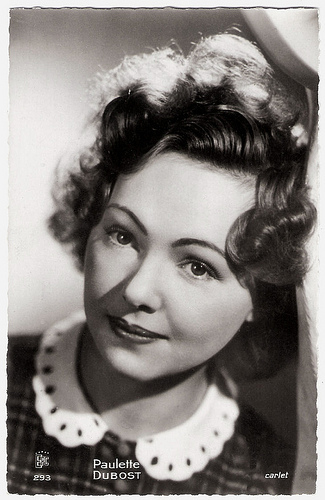
French postcard by Editions et Publications Cinématographiques (EPC), no. 293. Photo: Carlet.
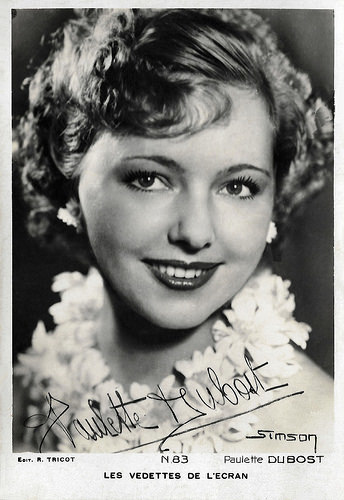
French postcard by Edit. R. Tricot in the Les vedettes de l'ecran series, no. 83. Photo: Simson.
Happy Go Lucky
After the war, Paulette Dubost co-starred with Danielle Darrieux in Au Petit Bonheur/Happy Go Lucky (Marcel L'Herbier, 1946), derived from a stage play written by Marc Gilbert Sauvajon.
She appeared in the interesting Swiss post-war drama Die Vier im Jeep/Four in a Jeep (Leopold Lindtberg, 1951) starring Viveca Lindfors and Ralph Meeker.
Max Ophüls then gave Paulette Dubost parts in Le plaisir/Pleasure (1951), based on three short stories by of Guy de Maupassant, and in Lola Montes (1955) starring Martine Carol .
She played another supporting part in Le Dejeuner sur L'Herbe/Picnic on the Grass (Jean Renoir, 1959). This film was inspired by the impressionist paintings by the director's father, Auguste Renoir.
Dubost adapted easily to the evolution of film and the demands of directors. She worked with many big names of the French cinema: Jean Renoir, Claude Autant-Lara, Louis Malle, Philippe De Broca, Francois Truffaut, etc.
In 1992, she published a memoir entitled C'est court la vie (It's a short life). Even in old age she continued to perform in films. Her last film appearance was in the short film Curriculum (Alexander Moix), 2007.
Paulette Dubost died in Lonjumeau, France in 2011, 100 years old. She was married to Andre Ostertag from 1936 till 1944. They had a daughter, born in 1942.
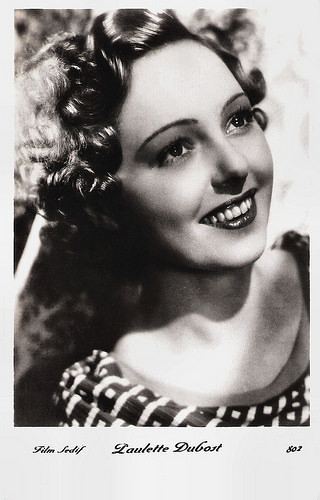
French postcard, no. 801. Photo: Film Sedif. Probably a publicity still for Le mensonge de Nina Petrovna/The Lie of Nina Petrovna (Victor Tourjansky, 1937), which was distributed by Societé d'Exploitation et de Distribution de Films (SEDIF).
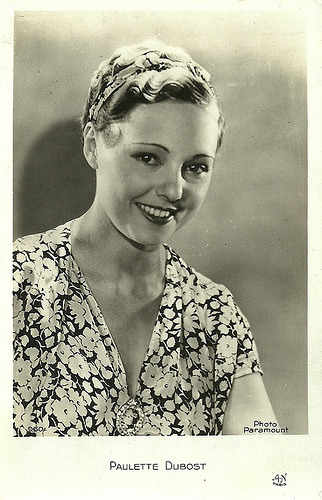
French postcard by A.N., Paris. Photo: Paramount.
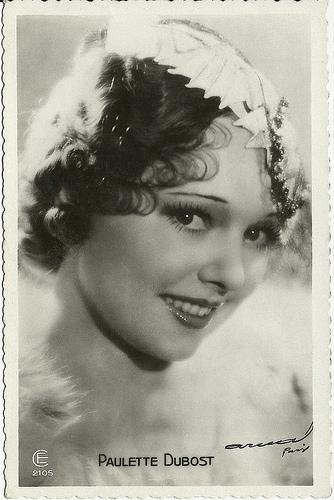
French postcard by Editions Cinématographiques, no. 2105. Photo: Arnal, Paris. Collection: Didier Hanson.
Paulette Dubost sings Si Maman le veut (1934) in the film Le Comte Obligado (1934). Source: Camille 885 (YouTube).
Sources: Hal Erickson (AllMovie), Hans Beerekamp (Het Schimmenrijk - Dutch), Wikipedia and .

French postcard by Editions et Publications Cinématographiques (EPC), no. 293. Photo: Carlet.

French autograph card. Photo: Forster / Film EPOC. Publicity still for Jeunesse/Youth (Georges Lacombe, 1933).

French postcard by Erpé, no. 8. Photo: Simson.

French postcard, no. 39. Photo: Forster.

French postcard by EPC, no. 36. Photo: Studio Harcourt.
Great Classics
Paulette Dubost was born Paulette Marie Emma Deplanque in Paris, France, in 1910. Her father was a gas engineer and her mother a singer at the Opéra Comique.
Paulette began her career at the age of 7 at the Opéra de Paris. At 17, she switched to operetta and played for two years in Les Aventures du roi Pausole (The Adventures of King Pausole) at the Bouffes Parisiens with Simone Simon , Edwige Feuillère and Viviane Romance .
Her naughty look and her voice were quickly noticed by the cinema, and from 1930 on she played roles in films by Jacques Tourneur, Jean Renoir, Andre Cayatte, Gilles Grangier and Max Ophuls.
In Le roi des Champs-Élysées/The King of the Champs Elysees (Max Nosseck, 1935), she appeared opposite the famous silent film star Buster Keaton in a dual role.
Dubost played a supporting part in Hotel du Nord/North Hotel (1936), starring Annabella and Jean-Pierre Aumont . It was the second of Marcel Carné's trio of 'fatalistic romantic melodramas'.
Her most famous film from this period is Jean Renoir's La Règle du jeu/Rules of the Game (1939). Though it's now regarded as one of the great classics of the French film, it was not warmly received on its original release in 1939.

French postcard by EC, no. 57. Photo: Studio Arnal.

French autograph card, no. 57. Photo: publicity still for La caserne en folie/The barracks in madness (Maurice Cammage, 1935).

French postcard by Editions et Publications Cinématographiques (EPC), no. 125. Photo: Simson.

French postcard by Editions et Publications Cinématographiques (EPC), no. 293. Photo: Carlet.

French postcard by Edit. R. Tricot in the Les vedettes de l'ecran series, no. 83. Photo: Simson.
Happy Go Lucky
After the war, Paulette Dubost co-starred with Danielle Darrieux in Au Petit Bonheur/Happy Go Lucky (Marcel L'Herbier, 1946), derived from a stage play written by Marc Gilbert Sauvajon.
She appeared in the interesting Swiss post-war drama Die Vier im Jeep/Four in a Jeep (Leopold Lindtberg, 1951) starring Viveca Lindfors and Ralph Meeker.
Max Ophüls then gave Paulette Dubost parts in Le plaisir/Pleasure (1951), based on three short stories by of Guy de Maupassant, and in Lola Montes (1955) starring Martine Carol .
She played another supporting part in Le Dejeuner sur L'Herbe/Picnic on the Grass (Jean Renoir, 1959). This film was inspired by the impressionist paintings by the director's father, Auguste Renoir.
Dubost adapted easily to the evolution of film and the demands of directors. She worked with many big names of the French cinema: Jean Renoir, Claude Autant-Lara, Louis Malle, Philippe De Broca, Francois Truffaut, etc.
In 1992, she published a memoir entitled C'est court la vie (It's a short life). Even in old age she continued to perform in films. Her last film appearance was in the short film Curriculum (Alexander Moix), 2007.
Paulette Dubost died in Lonjumeau, France in 2011, 100 years old. She was married to Andre Ostertag from 1936 till 1944. They had a daughter, born in 1942.

French postcard, no. 801. Photo: Film Sedif. Probably a publicity still for Le mensonge de Nina Petrovna/The Lie of Nina Petrovna (Victor Tourjansky, 1937), which was distributed by Societé d'Exploitation et de Distribution de Films (SEDIF).

French postcard by A.N., Paris. Photo: Paramount.

French postcard by Editions Cinématographiques, no. 2105. Photo: Arnal, Paris. Collection: Didier Hanson.
Paulette Dubost sings Si Maman le veut (1934) in the film Le Comte Obligado (1934). Source: Camille 885 (YouTube).
Sources: Hal Erickson (AllMovie), Hans Beerekamp (Het Schimmenrijk - Dutch), Wikipedia and .
Published on February 06, 2018 22:00
February 5, 2018
Anna-Maria Ferrero
With her fragile beauty and assured talent, Italian actress Anna-Maria Ferrero (1934) made a respectable impact in the Italian cinema of the 1950s. As a teenager she started playing leads in films by Michelangelo Antonioni, Mario Monicelli, Mauro Bolognini and other major directors, and she would star in many stage plays and films opposite her boyfriend Vittorio Gassman.

Italian postcard by Bromofoto, Milano, no. 340. Photo: Minerva Film.
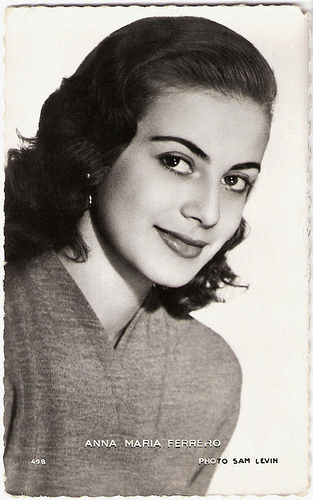
French postcard by P.I., Paris, no. 49 B. Photo: Sam Lévin.

Vintage card. Photo: Video.

Italian postcard by Bromofoto, Milano (Milan), no. 466. Photo: publicity still for Febbre di vivere/Eager to live (Claudio Gora, 1953) with Sandro Milani.
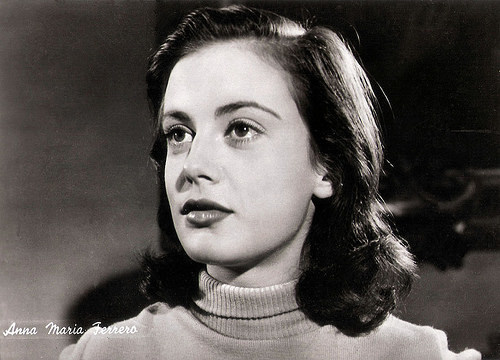
Italian postcard by Bromofoto, no. 408.
Graphic-for-its-times Sexual Content
Anna-Maria Ferrero was born Anna Maria Guerra in Rome in 1934.
At age 15, she debuted on screen in Il cielo è rosso/The sky is red (Claudio Gora, 1950). Director Claudio Gori had spotted her walking through Via Aurora in Rome, and had offered her a screen test.
At AllMovie, Hal Erickson writes: “The Italian The Sky is Red (Il Cielo è Rosso) details the romantic adventures of two postwar couples. Despite being confined to a quarantined zone (quarantined for political, rather than health reasons), love finds a way. The Neorealistic elements are passable, but what really 'sold' this film abroad was its graphic-for-its-times sexual content. The cast is headed by Jacques Sernas and Marina Berti , another step in the right direction box office-wise.”
Anna Maria changed her last name in honour of famous musical director and conductor Willy Ferrero, who was her godfather. Her next roles were in Domani è un altro giorno/Tomorrow is another day (Léonide Moguy, 1951) starring Pier Angeli , and opposite Raf Vallone in Il Cristo proibito/The forbidden Christ (1951), the only film directed by famous author Curzio Malaparte.
In Le infedeli/The Unfaithfuls (Mario Monicelli, Steno, 1953), she appeared with Gina Lollobrigida . Her delicate, photogenic beauty and assured talent attracted director Michelangelo Antonioni, who cast her opposite Franco Interlenghi in the Italian episode of his I vinti/Youth and Perversion (Michelangelo Antonioni, 1953), three stories of well-off youths who commit murders, one taking place in Paris, another in Rome, and another in London.
The following year she co-starred with Marcello Mastroianni in Cronache di poveri amanti/Chronicle of Poor Lovers (Carlo Lizzani, 1954). Her rich role in this film was noted by the critics and the film went on to win the International Prize at the Cannes Film Festival.
Next she starred opposite Alberto Sordi in Una parigina a Roma/A Parisian in Rome (Erich Kobler, 1954), and with comedy star Totò in Totò e Carolina/Toto and Carolina (Mario Monicelli, 1955). On television she starred in 1956 in the drama Cime tempestose/Wuthering Heights alongside Massimo Girotti .
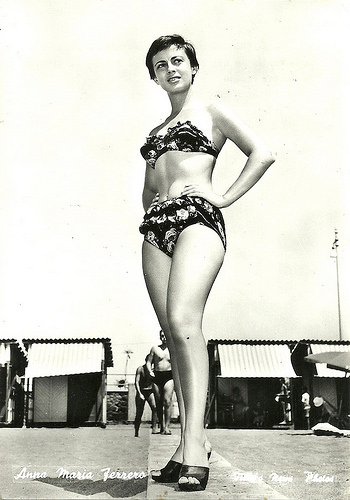
Italian postcard in the Italy's News Photos by Bromofoto, Milano, no. 1244.

Italian postcard by Bromostampa, Milano, no. 295.

German postcard by Universum-Film Aktiengesellschaft (Ufa), Berlin-Tempelhof, no. FK 1217. Retail price: 25 Pfg. Photo: Dial-Unitalia Film, Rome.
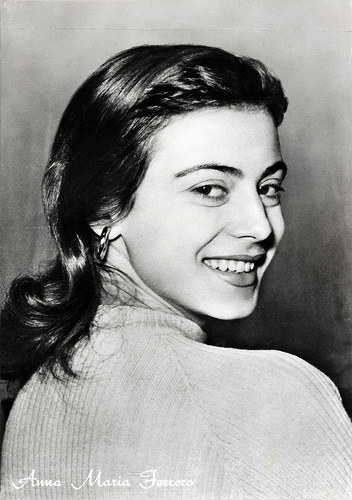
Italian postcard by Rotalfoto, Milano, no. 363. Photo: Universalfoto.
Gassman and Sorel
Although her career would only span some 15 years, Anna-Maria Ferrero achieved reasonable status in the Italian cinema. She acted rarely outside Italy, but she was featured in the star-studded Paramount epic War and Peace (King Vidor, 1956) starring Audrey Hepburn , Mel Ferrer and Henry Fonda.
Another co-star in this production filmed in Cinecittà was Vittorio Gassman , who had been her partner since 1953. The couple often worked together. On stage, she had joined his theatre company and worked there for several seasons. Notable were her Ophelia in Hamlet, Desdemona in Othello and her title role in the musical Irma la Douce.
In the cinema, Ferrero and Gassman starred together in the Alexandre Dumas' drama Kean/Kean: Genius or Scoundrel (Vittorio Gassman, Francesco Rosi, 1956), the adventure Giovanni dalle bande nere/The violent patriot (Sergio Grieco, 1956), the romantic comedy Le sorprese dell'amore/Surprise of love (Luigi Comencini, 1959), the drama La notte brava/Bad Girls Don't Cry (Mauro Bolognini, 1959) and the comedy Il mattatore/Love and larceny (Dino Risi, 1960). In 1960 their relationship ended.
Ferrero had some spirited performances in the adventurous Il gobbo/The Hunchback of Rome (Carlo Lizzani, 1961), and L'oro di Roma/Gold of Rome (Carlo Lizzani, 1961), both with Gérard Blain .
The following year she married the French actor Jean Sorel , with whom she starred in the comedy Un marito in condominio/A husband in the condominium (Angelo Dorigo, 1963).
Ettore Scola directed her opposite Nino Manfredi in Cocaina di domenica/Cocaine on Sunday, an episode of the anthology film Controsesso/Countersex (1965), in which a husband and wife start snorting cocaine after the friend who owned the bottle with the drug is arrested.
Then, at the age of 37, Anna Maria Ferrero suddenly ended her career. Her retirement surprised many, but in the following decades she never made a come-back to the film world. Anna Maria Ferrero is still married to Jean Sorel .
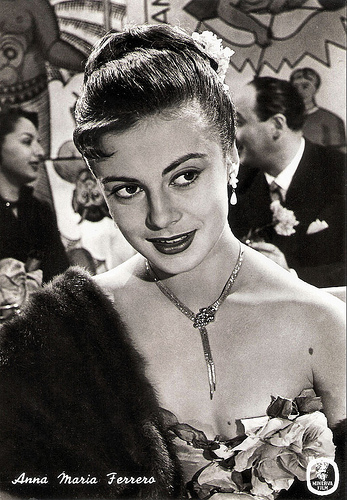
Italian postcard by Bromofoto, no. 721. Photo: Minerva Film. Publicity still for Canzoni di mezzo secolo/Half a Century of Song (Domenico Paolella, 1954).

Italian postcard by Vetta Traldi, Milano in the Divi del Cinema series, no. 51. Sent by mail in 1955.
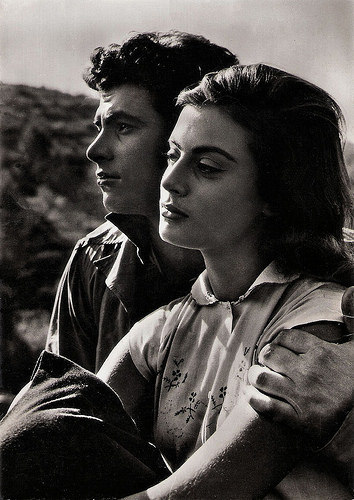
Italian postcard by Rotalfoto, Milano. Photo: Ponti - De Laurentiis. Publicity still for Totò e Carolina/Totò and Carolina (Mario Monicelli, 1955) with Maurizio Arena .
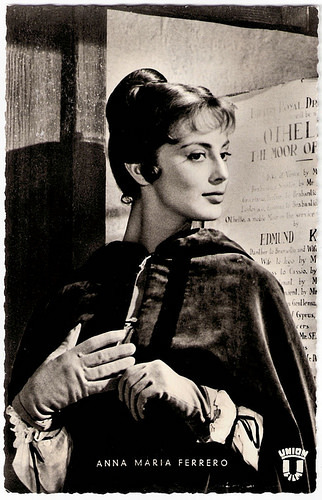
German postcard by Kunst und Bild, Berlin-Charlottenburg, no. I 282. Photo: Union Film. Publicity still for Kean - Genio e sregolatezza/Kean: Genius or Scoundrel (Vittorio Gassman, Francesco Rosi, 1957).
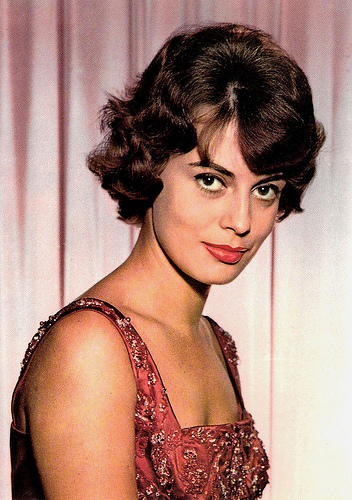
Italian postcard by Rotalfoto, Milano (Milan), no. 60.
Sources: (IMDb), Hal Erickson (AllMovie), Wikipedia (English and Italian) and .

Italian postcard by Bromofoto, Milano, no. 340. Photo: Minerva Film.

French postcard by P.I., Paris, no. 49 B. Photo: Sam Lévin.

Vintage card. Photo: Video.

Italian postcard by Bromofoto, Milano (Milan), no. 466. Photo: publicity still for Febbre di vivere/Eager to live (Claudio Gora, 1953) with Sandro Milani.

Italian postcard by Bromofoto, no. 408.
Graphic-for-its-times Sexual Content
Anna-Maria Ferrero was born Anna Maria Guerra in Rome in 1934.
At age 15, she debuted on screen in Il cielo è rosso/The sky is red (Claudio Gora, 1950). Director Claudio Gori had spotted her walking through Via Aurora in Rome, and had offered her a screen test.
At AllMovie, Hal Erickson writes: “The Italian The Sky is Red (Il Cielo è Rosso) details the romantic adventures of two postwar couples. Despite being confined to a quarantined zone (quarantined for political, rather than health reasons), love finds a way. The Neorealistic elements are passable, but what really 'sold' this film abroad was its graphic-for-its-times sexual content. The cast is headed by Jacques Sernas and Marina Berti , another step in the right direction box office-wise.”
Anna Maria changed her last name in honour of famous musical director and conductor Willy Ferrero, who was her godfather. Her next roles were in Domani è un altro giorno/Tomorrow is another day (Léonide Moguy, 1951) starring Pier Angeli , and opposite Raf Vallone in Il Cristo proibito/The forbidden Christ (1951), the only film directed by famous author Curzio Malaparte.
In Le infedeli/The Unfaithfuls (Mario Monicelli, Steno, 1953), she appeared with Gina Lollobrigida . Her delicate, photogenic beauty and assured talent attracted director Michelangelo Antonioni, who cast her opposite Franco Interlenghi in the Italian episode of his I vinti/Youth and Perversion (Michelangelo Antonioni, 1953), three stories of well-off youths who commit murders, one taking place in Paris, another in Rome, and another in London.
The following year she co-starred with Marcello Mastroianni in Cronache di poveri amanti/Chronicle of Poor Lovers (Carlo Lizzani, 1954). Her rich role in this film was noted by the critics and the film went on to win the International Prize at the Cannes Film Festival.
Next she starred opposite Alberto Sordi in Una parigina a Roma/A Parisian in Rome (Erich Kobler, 1954), and with comedy star Totò in Totò e Carolina/Toto and Carolina (Mario Monicelli, 1955). On television she starred in 1956 in the drama Cime tempestose/Wuthering Heights alongside Massimo Girotti .

Italian postcard in the Italy's News Photos by Bromofoto, Milano, no. 1244.

Italian postcard by Bromostampa, Milano, no. 295.

German postcard by Universum-Film Aktiengesellschaft (Ufa), Berlin-Tempelhof, no. FK 1217. Retail price: 25 Pfg. Photo: Dial-Unitalia Film, Rome.

Italian postcard by Rotalfoto, Milano, no. 363. Photo: Universalfoto.
Gassman and Sorel
Although her career would only span some 15 years, Anna-Maria Ferrero achieved reasonable status in the Italian cinema. She acted rarely outside Italy, but she was featured in the star-studded Paramount epic War and Peace (King Vidor, 1956) starring Audrey Hepburn , Mel Ferrer and Henry Fonda.
Another co-star in this production filmed in Cinecittà was Vittorio Gassman , who had been her partner since 1953. The couple often worked together. On stage, she had joined his theatre company and worked there for several seasons. Notable were her Ophelia in Hamlet, Desdemona in Othello and her title role in the musical Irma la Douce.
In the cinema, Ferrero and Gassman starred together in the Alexandre Dumas' drama Kean/Kean: Genius or Scoundrel (Vittorio Gassman, Francesco Rosi, 1956), the adventure Giovanni dalle bande nere/The violent patriot (Sergio Grieco, 1956), the romantic comedy Le sorprese dell'amore/Surprise of love (Luigi Comencini, 1959), the drama La notte brava/Bad Girls Don't Cry (Mauro Bolognini, 1959) and the comedy Il mattatore/Love and larceny (Dino Risi, 1960). In 1960 their relationship ended.
Ferrero had some spirited performances in the adventurous Il gobbo/The Hunchback of Rome (Carlo Lizzani, 1961), and L'oro di Roma/Gold of Rome (Carlo Lizzani, 1961), both with Gérard Blain .
The following year she married the French actor Jean Sorel , with whom she starred in the comedy Un marito in condominio/A husband in the condominium (Angelo Dorigo, 1963).
Ettore Scola directed her opposite Nino Manfredi in Cocaina di domenica/Cocaine on Sunday, an episode of the anthology film Controsesso/Countersex (1965), in which a husband and wife start snorting cocaine after the friend who owned the bottle with the drug is arrested.
Then, at the age of 37, Anna Maria Ferrero suddenly ended her career. Her retirement surprised many, but in the following decades she never made a come-back to the film world. Anna Maria Ferrero is still married to Jean Sorel .

Italian postcard by Bromofoto, no. 721. Photo: Minerva Film. Publicity still for Canzoni di mezzo secolo/Half a Century of Song (Domenico Paolella, 1954).

Italian postcard by Vetta Traldi, Milano in the Divi del Cinema series, no. 51. Sent by mail in 1955.

Italian postcard by Rotalfoto, Milano. Photo: Ponti - De Laurentiis. Publicity still for Totò e Carolina/Totò and Carolina (Mario Monicelli, 1955) with Maurizio Arena .

German postcard by Kunst und Bild, Berlin-Charlottenburg, no. I 282. Photo: Union Film. Publicity still for Kean - Genio e sregolatezza/Kean: Genius or Scoundrel (Vittorio Gassman, Francesco Rosi, 1957).

Italian postcard by Rotalfoto, Milano (Milan), no. 60.
Sources: (IMDb), Hal Erickson (AllMovie), Wikipedia (English and Italian) and .
Published on February 05, 2018 22:00
February 4, 2018
Lilian Ellis
In the late 1920s and early 1930s, Danish actress Lilian Ellis (1907-1951) had a short but glittering career in the German cinema. She was also a ballet dancer, a stage actress and a radio and television performer.
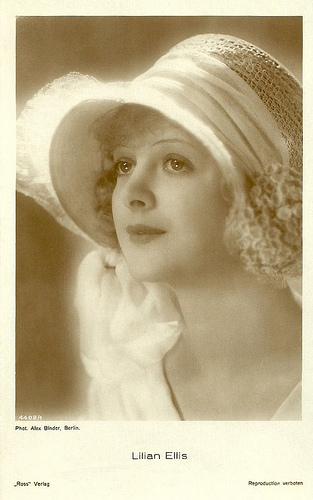
German postcard by Ross Verlag, no. 4408/1, 1929-1930. Photo: Alex Binder, Berlin.
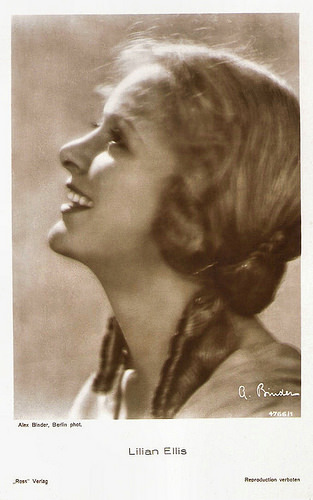
German postcard by Ross Verlag, no. 4766/1, 1929-1930. Photo: Alex Binder, Berlin.
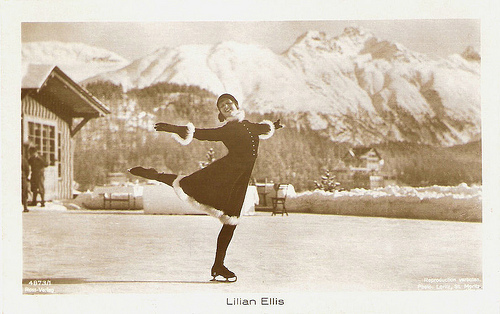
German postcard by Ross Verlag, no. 4873/1, 1929-1930. Photo: Loritz, St. Moritz.
Casanova
Lilian Ellis was born as Ellis Stampe Bendix in Denmark in 1907.
She started ballet training with Asta Mollerup and Jenny Møller, after which she danced as ballet dancer with groundbreaking Russian choreographer and dancer Michel Fokine in Paris. At the age of 16 she joined the company of Ellen Tels after which she raised her own dance company. She started to perform abroad in ballet and revue and joined Max Reinhardt’s Deutsche Theater in Berlin for a while.
In 1927 Lilian Ellis debuted in film with a small role in the French silent classic Casanova (Alexander Volkov, 1927), and the following year she already had a big part in Heut'spielt der Strauss/Strauss, the Waltz King (Conrad Wiene, 1928), scripted by Robert Wiene and starring Alfred Abel as Johan Strauss senior. The film portrays the relationship between the father and son Austrian composers Johann Strauss I and Johann Strauss II.
During the years 1928-1931, Ellis was a leading lady of the German cinema, playing many big parts in late silent and early sound films, including Der Leutnant Ihrer Majestät/Lieutenant of His Majesty (Jakob & Luise Fleck, 1929) with Iván Petrovich , Im Prater blüh'n wieder die Bäume/In the Prater the Trees are in Bloom Again (E.W.Emo, 1929), Liebeskleeblatt/Love's Clover Leaf (Max Nosseck, 1930), and the German-Austrain-Czech production Wiener Herzen.Viennese Hearts (Fred Sauer, 1930) with Werner Fuetterer .
Quite easily, Ellis made the passage to sound film with Georg Jacoby’s film Tausend Worte Deutsch/1000 Words German (1930), the first sound film of Pat & Patachon (Fy och Bi).
Then followed the films Der Bergführer von Zakopane/The mountain guide of Zakopane (Domenico Gambino, Adolf Trotz, 1931), Die lustige Weiber von Wien/The Merry Wives of Vienna (Géza von Bolváry, 1931) with Willi Forst , Die Frau von der man spricht/The Woman They Talk About (Victor Janson, 1931) with Mady Christians , Der Raub der Mona Lisa/The Theft of the Mona Lisa (Géza von Bolváry, 1931) with again Forst, Kyritz-Pyritz/ (Carl Heinz Wolff, 1931), and finally Schön ist die Manöverzeit/Manoeuver Time Is Fine (Erich Schönfelder, Margarete Schön, 1931) with Ida Wüst .
After that Ellis returned to Denmark.
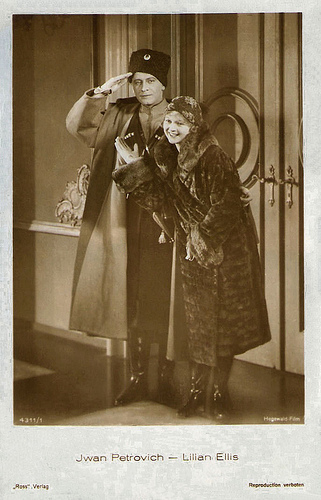
German postcard by Ross Verlag, no. 4311/1, 1929-1930. Photo: Hegewald-Film. Publicity still for Der Leutnant Ihrer Majestät/Court Scandal (Jacob Fleck, Luise Fleck, 1929) with Iván Petrovich .
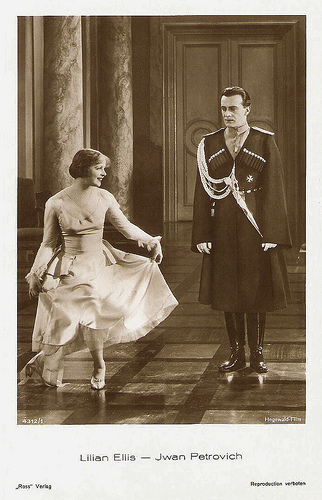
German postcard by Ross Verlag, no. 4312/1, 1929-1930. Photo: Hegewald-Film. Publicity still for Der Leutnant Ihrer Majestät/Court Scandal (Jacob Fleck, Luise Fleck, 1929) with Iván Petrovich .
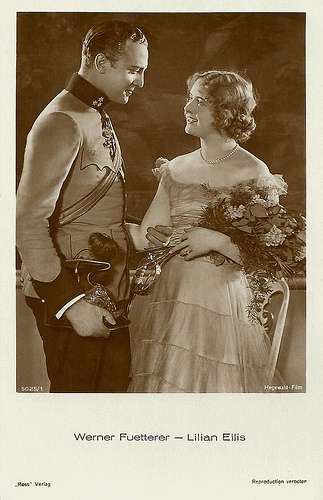
German postcard by Ross Verlag, no. 5025/1, 1930-1931. Photo: Hegewald-Film. Lilian Ellis and Werner Fuetterer played together in Wiener Herzen (Fred Sauer, 1930), a late silent film and a German-Austrian-Czech co-production.
Hollywood-contract
From 1933 on Lilian Ellis toured from Paris to Warsaw. In 1934 Ellis was offered a Hollywood–contract but she remained in Europe, and acted with Det Ny Teater and from 1935 on at the National Scala.
The next year she acted in London and Paris revues. She collaborated with the revue Tomands-fronten (1941) at the Apolloteatret with Hans W. Petersen.
When the Second World War broke out, she returned to the set for the Danish operetta-like show film Alle går rundt og forelsker sig/All goes around and everyone falls in love (Emanuel Gregers, 1941). Ellis played an operetta girl who bets with the other girls she can bring three men on their knees, but one is not so easily conquered.
The film was such a success in Sweden that Ellis was offered a contract there. She played in the Swedish romantic comedy En melodi om våren/A Springtime Melody (Weyler Hildebrand, 1943), in which she played a nightclub singer. It was her last leading role.
That same year, Ellis married editor Mogens Lind in Stockholm. En melodi om våren flopped, so Ellis stopped making films in Sweden. After that she only had a major part in the Danish film Elly Petersen (Jon Iversen, Alice O'Fredericks, 1944) and a small part in De kloge og vi gale/The Wise Man and the Fool (Alice O'Fredericks, Lau Lauritzen jun., 1945), plus some stage performances.
Ellis gave her voice to the radio of Sweden, Norway and the British Forces Network, thanks to her eloquence and diction. In 1948 she did her first radio and television performance in New York and Washington. Together with Mogens Lind she translated a series of British and American plays, such as Fallen Angel and the operetta Annie. She also contributed to the popular Danish radio show Han, Hun og Musikken.
In 1951, Lilian Ellis was hospitalised at the Bispebjerg Hospital and operated for a serious kidney disease. A blood congestion became fatal, and Lilian Ellis died at the age of 43 in 1951. In 1952 Mogens Lind edited the book Til Elise.
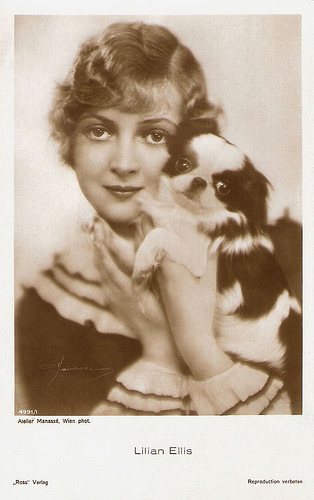
German postcard by Ross Verlag, no. 4991/1, 1929-1930. Photo: Manassé, Wien.
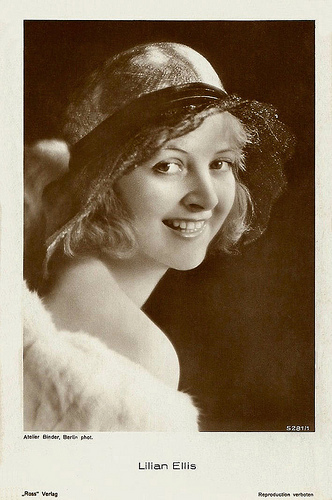
German postcard by Ross Verlag, no. 5281/1, 1930-1931. Photo: Atelier Binder, Berlin.
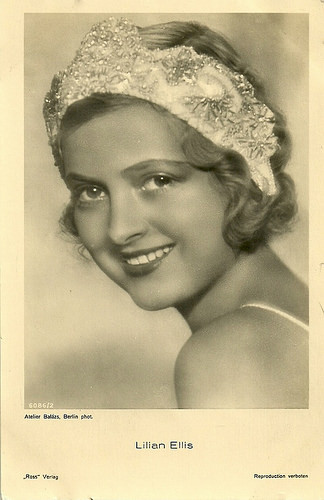
German postcard by Ross Verlag, no. 6086/2, 1931-1932. Photo: Atelier Balàzs, Berlin.
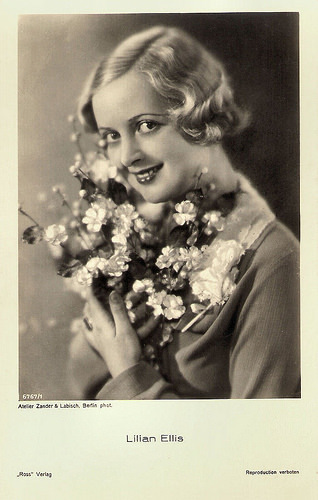
German postcard by Ross Verlag, no. 6767/1, 1931-1932. Photo: Zander & Labisch, Berlin.
Sources: Danske Film (Danish), Danish Film Institute (Danish), Thomas Staedeli (Cyranos - German), Wikipedia (Danish and English) and .

German postcard by Ross Verlag, no. 4408/1, 1929-1930. Photo: Alex Binder, Berlin.

German postcard by Ross Verlag, no. 4766/1, 1929-1930. Photo: Alex Binder, Berlin.

German postcard by Ross Verlag, no. 4873/1, 1929-1930. Photo: Loritz, St. Moritz.
Casanova
Lilian Ellis was born as Ellis Stampe Bendix in Denmark in 1907.
She started ballet training with Asta Mollerup and Jenny Møller, after which she danced as ballet dancer with groundbreaking Russian choreographer and dancer Michel Fokine in Paris. At the age of 16 she joined the company of Ellen Tels after which she raised her own dance company. She started to perform abroad in ballet and revue and joined Max Reinhardt’s Deutsche Theater in Berlin for a while.
In 1927 Lilian Ellis debuted in film with a small role in the French silent classic Casanova (Alexander Volkov, 1927), and the following year she already had a big part in Heut'spielt der Strauss/Strauss, the Waltz King (Conrad Wiene, 1928), scripted by Robert Wiene and starring Alfred Abel as Johan Strauss senior. The film portrays the relationship between the father and son Austrian composers Johann Strauss I and Johann Strauss II.
During the years 1928-1931, Ellis was a leading lady of the German cinema, playing many big parts in late silent and early sound films, including Der Leutnant Ihrer Majestät/Lieutenant of His Majesty (Jakob & Luise Fleck, 1929) with Iván Petrovich , Im Prater blüh'n wieder die Bäume/In the Prater the Trees are in Bloom Again (E.W.Emo, 1929), Liebeskleeblatt/Love's Clover Leaf (Max Nosseck, 1930), and the German-Austrain-Czech production Wiener Herzen.Viennese Hearts (Fred Sauer, 1930) with Werner Fuetterer .
Quite easily, Ellis made the passage to sound film with Georg Jacoby’s film Tausend Worte Deutsch/1000 Words German (1930), the first sound film of Pat & Patachon (Fy och Bi).
Then followed the films Der Bergführer von Zakopane/The mountain guide of Zakopane (Domenico Gambino, Adolf Trotz, 1931), Die lustige Weiber von Wien/The Merry Wives of Vienna (Géza von Bolváry, 1931) with Willi Forst , Die Frau von der man spricht/The Woman They Talk About (Victor Janson, 1931) with Mady Christians , Der Raub der Mona Lisa/The Theft of the Mona Lisa (Géza von Bolváry, 1931) with again Forst, Kyritz-Pyritz/ (Carl Heinz Wolff, 1931), and finally Schön ist die Manöverzeit/Manoeuver Time Is Fine (Erich Schönfelder, Margarete Schön, 1931) with Ida Wüst .
After that Ellis returned to Denmark.

German postcard by Ross Verlag, no. 4311/1, 1929-1930. Photo: Hegewald-Film. Publicity still for Der Leutnant Ihrer Majestät/Court Scandal (Jacob Fleck, Luise Fleck, 1929) with Iván Petrovich .

German postcard by Ross Verlag, no. 4312/1, 1929-1930. Photo: Hegewald-Film. Publicity still for Der Leutnant Ihrer Majestät/Court Scandal (Jacob Fleck, Luise Fleck, 1929) with Iván Petrovich .

German postcard by Ross Verlag, no. 5025/1, 1930-1931. Photo: Hegewald-Film. Lilian Ellis and Werner Fuetterer played together in Wiener Herzen (Fred Sauer, 1930), a late silent film and a German-Austrian-Czech co-production.
Hollywood-contract
From 1933 on Lilian Ellis toured from Paris to Warsaw. In 1934 Ellis was offered a Hollywood–contract but she remained in Europe, and acted with Det Ny Teater and from 1935 on at the National Scala.
The next year she acted in London and Paris revues. She collaborated with the revue Tomands-fronten (1941) at the Apolloteatret with Hans W. Petersen.
When the Second World War broke out, she returned to the set for the Danish operetta-like show film Alle går rundt og forelsker sig/All goes around and everyone falls in love (Emanuel Gregers, 1941). Ellis played an operetta girl who bets with the other girls she can bring three men on their knees, but one is not so easily conquered.
The film was such a success in Sweden that Ellis was offered a contract there. She played in the Swedish romantic comedy En melodi om våren/A Springtime Melody (Weyler Hildebrand, 1943), in which she played a nightclub singer. It was her last leading role.
That same year, Ellis married editor Mogens Lind in Stockholm. En melodi om våren flopped, so Ellis stopped making films in Sweden. After that she only had a major part in the Danish film Elly Petersen (Jon Iversen, Alice O'Fredericks, 1944) and a small part in De kloge og vi gale/The Wise Man and the Fool (Alice O'Fredericks, Lau Lauritzen jun., 1945), plus some stage performances.
Ellis gave her voice to the radio of Sweden, Norway and the British Forces Network, thanks to her eloquence and diction. In 1948 she did her first radio and television performance in New York and Washington. Together with Mogens Lind she translated a series of British and American plays, such as Fallen Angel and the operetta Annie. She also contributed to the popular Danish radio show Han, Hun og Musikken.
In 1951, Lilian Ellis was hospitalised at the Bispebjerg Hospital and operated for a serious kidney disease. A blood congestion became fatal, and Lilian Ellis died at the age of 43 in 1951. In 1952 Mogens Lind edited the book Til Elise.

German postcard by Ross Verlag, no. 4991/1, 1929-1930. Photo: Manassé, Wien.

German postcard by Ross Verlag, no. 5281/1, 1930-1931. Photo: Atelier Binder, Berlin.

German postcard by Ross Verlag, no. 6086/2, 1931-1932. Photo: Atelier Balàzs, Berlin.

German postcard by Ross Verlag, no. 6767/1, 1931-1932. Photo: Zander & Labisch, Berlin.
Sources: Danske Film (Danish), Danish Film Institute (Danish), Thomas Staedeli (Cyranos - German), Wikipedia (Danish and English) and .
Published on February 04, 2018 22:00
Paul van Yperen's Blog
- Paul van Yperen's profile
- 13 followers
Paul van Yperen isn't a Goodreads Author
(yet),
but they
do have a blog,
so here are some recent posts imported from
their feed.



